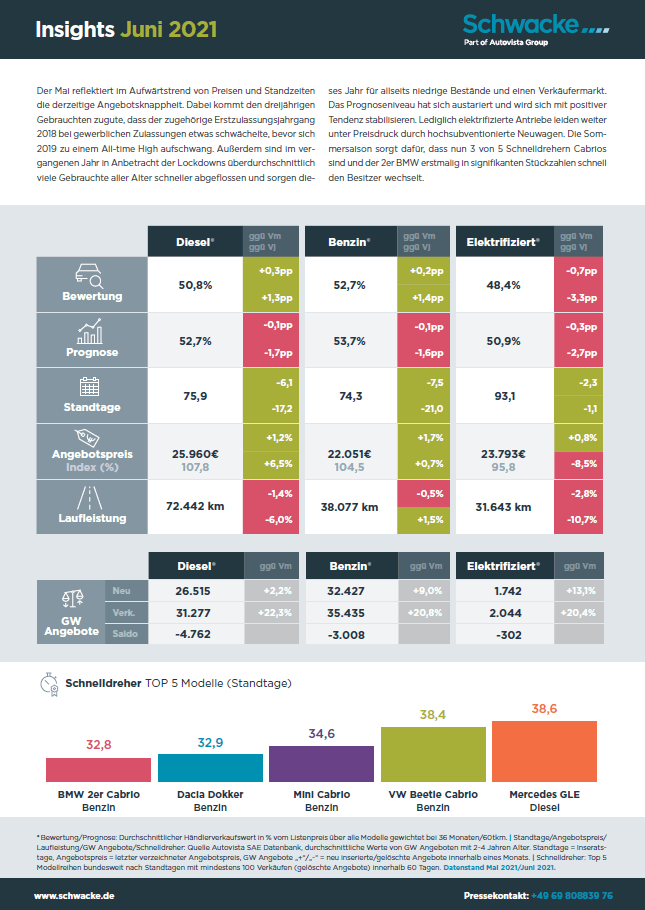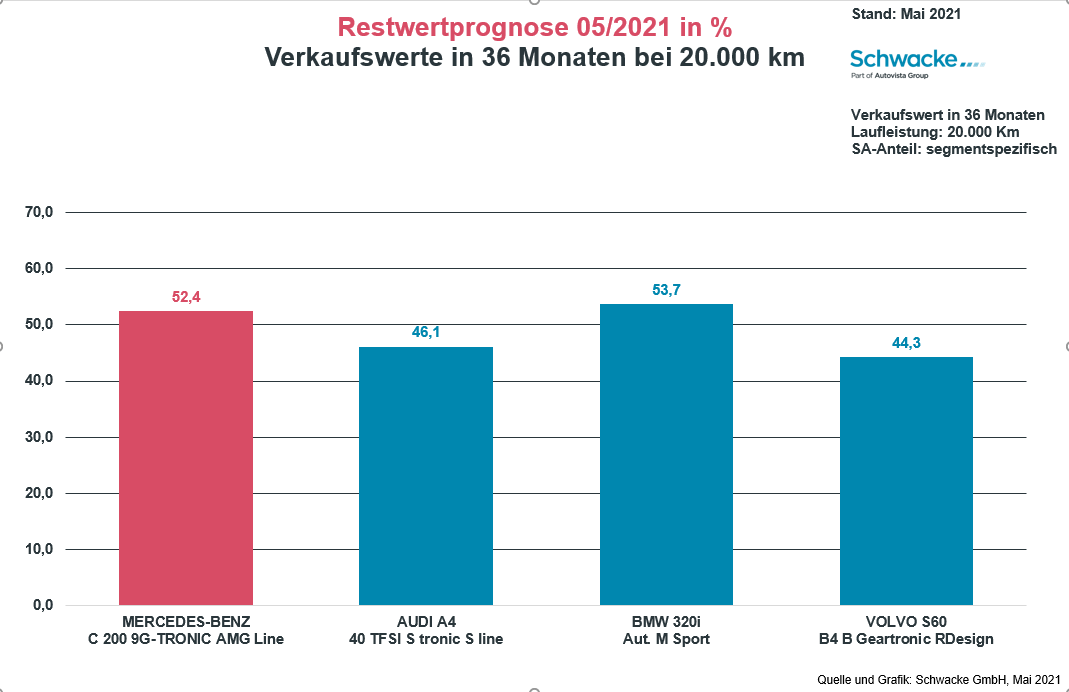Der Mai reflektiert im Aufwärtstrend von Preisen und Standzeiten die derzeitige Angebotsknappheit. Dabei kommt den dreijährigen Gebrauchten zugute, dass der zugehörige Erstzulassungsjahrgang 2018 bei gewerblichen Zulassungen etwas schwächelte, bevor sich 2019 zu einem All-time High aufschwang. Außerdem sind im vergangenen Jahr in Anbetracht der Lockdowns überdurchschnittlich viele Gebrauchte aller Alter schneller abgeflossen und sorgen dieses Jahr für allseits niedrige Bestände und einen Verkäufermarkt. Das Prognoseniveau hat sich austariert und wird sich mit positiver Tendenz stabilisieren. Lediglich elektrifizierte Antriebe leiden weiter unter Preisdruck durch hochsubventionierte Neuwagen. Die Sommersaison sorgt dafür, dass nun 3 von 5 Schnelldrehern Cabrios sind und der 2er BMW erstmalig in signifikanten Stückzahlen schnell den Besitzer wechselt.
Article Type: Insights
BEV vs ICE: a race to price parity
Battery-electric vehicles (BEVs) will achieve price parity with their fossil-fuel counterparts across Europe from 2027 at the latest. This is according to the results of a new Bloomberg NEF study commissioned by the clean-transport campaign group Transport and Environment (T&E).
Electrically-chargeable vehicle (EV) adoption is increasing with help from incentive programmes and expanding model offerings. In the first quarter of this year, BEVs accounted for 5.7% of EU new-car registrations, an increase of 59.1% compared to the first three months of 2020. Plug-in hybrids (PHEVs) took 8.2% of the market, equating to an increase of 175%. Meanwhile, diesel and petrol-powered cars continued to see falling volumes.
!function(){„use strict“;window.addEventListener(„message“,(function(a){if(void 0!==a.data[„datawrapper-height“])for(var e in a.data[„datawrapper-height“]){var t=document.getElementById(„datawrapper-chart-„+e)||document.querySelector(„iframe[src*='“+e+“‚]“);t&&(t.style.height=a.data[„datawrapper-height“][e]+“px“)}}))}();
However, the automotive industry is still in the early stages of electrification. Presently, those investing in EVs have both the confidence and capital to invest in electric drivetrains. As components, particularly batteries, become cheaper and more technologically advanced, EV price tags should shrink.
Price parity
The segment will dictate a BEV’s point of price parity with petrol in the coming years, with larger vehicles becoming more affordable more quickly. According to the BloombergNEF study, light vans will lead the charge, becoming cheaper than their ICE counterparts in 2025. BEVs in the C and D segments will follow in 2026, while small cars (B segment) bring up the rear in 2027.
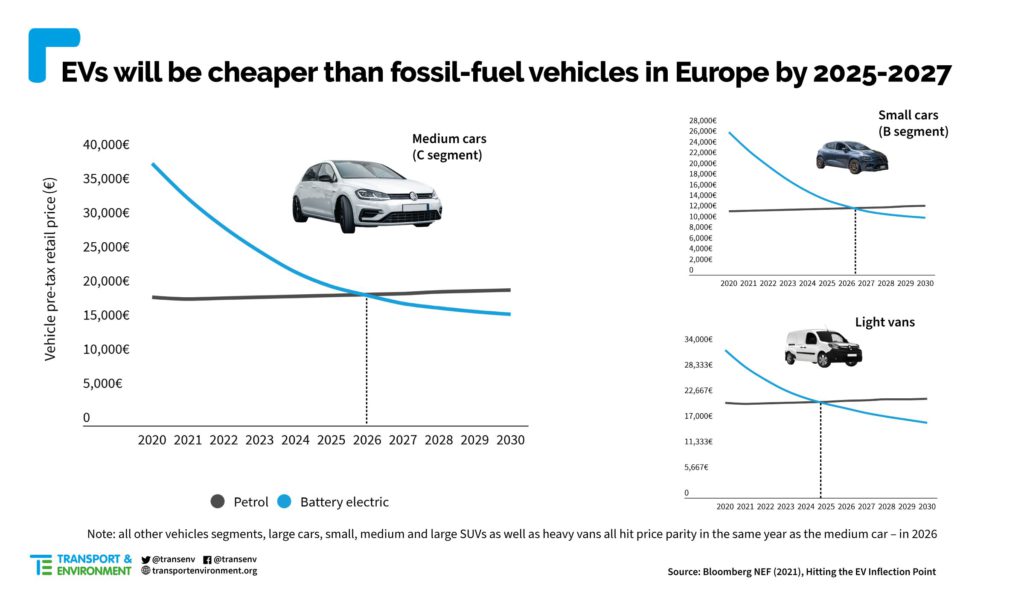
Source: T&E
‘EVs will be a reality for all new buyers within six years,’ said Julia Poliscanova, senior director for vehicles and e-mobility at T&E. ‘They will be cheaper than combustion engines for everyone, from the man with a van in Berlin to the family living in the Romanian countryside. Electric vehicles are not only better for the climate and Europe’s industrial leadership, but for the economy too.’
Building better batteries
So, what will be the driving force behind shrinking costs? The BloombergNEF study points to falling battery costs, new vehicle architectures and dedicated production lines as leading factors in reducing price, even before subsidies come into the equation. ‘An optimal vehicle design, produced in high volumes, can be more than a third cheaper by 2025 compared to now,’ the study states.
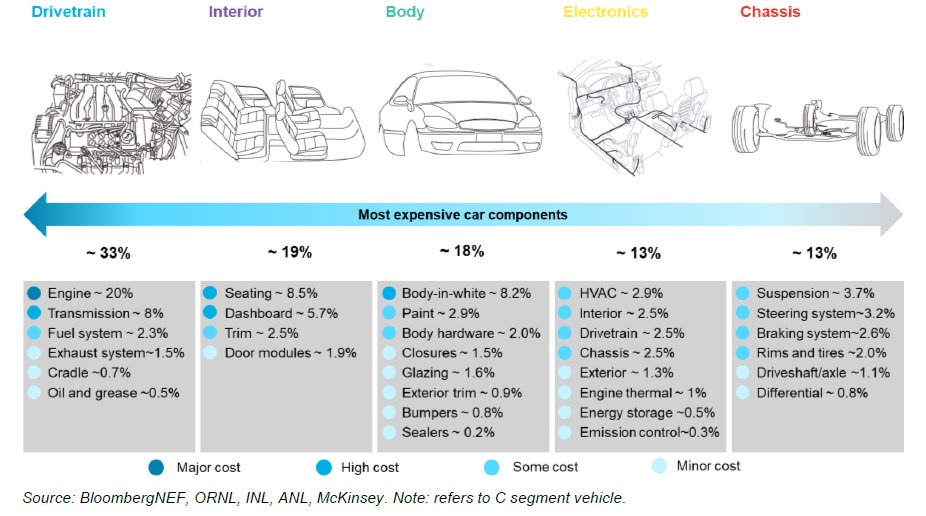
Source: T&E
Batteries in particular have had an important role to play as they have consistently been the most expensive EV component over the past decade. In the US, they currently account for roughly 30% of an EV’s cost. In Europe, prices are more widely spread, raising the continent’s average battery price above the global average – resulting partly from some lower-volume orders. But as battery prices fall and more optimised platforms are developed, EV prices should follow.
‘New chemistries, better manufacturing methods, innovative cell and pack-design concepts and other factors contribute to average prices per kilowatt-hour declining by 58% from 2020 to 2030,’ BloombergNEF points out. Past this point, new technologies like the solid-state battery will continue to drive down price. These smaller, more powerful units are seeing an uptick in interest from OEMs. Most recently, BMW and Ford led an investment round in Solid Power, a producer of solid-state batteries.
Plugged-in projections
Europe could see 4.3 million plug-in vehicles sold in 2025, representing roughly 28% of the market. BEVs would capture over half of those sales, with the rest made up by PHEVs as carmakers use them to meet emissions targets. In an economics-driven scenario, BloombergNEF believes BEVs could claim up to half of Europe’s market share of sales by 2030 and 85% by 2035.
T&E points out that battery-electric cars and e-vans could reach 100% of new sales by 2035 – including southern and eastern Europe, where initial take-up rates have been comparatively slow. However, this would be dependent upon lawmakers ramping up CO2 targets and producing policies to stimulate market developments including the introduction of more infrastructure. The environmental group states that without these additional policies, battery-electric cars will claim 85% of the EU market and e-vans 83%. This would mean missing Europe’s goal to decarbonise by 2050.
‘With the right policies, battery-electric cars and vans can reach 100% of sales by 2035 in western, southern and even eastern Europe,’ said Poliscanova. ‘The EU can set an end date in 2035 in the certainty that the market is ready. New polluting vehicles should not be sold for any longer than necessary.’
In April, T&E published the results of a poll of 15 European cities showing that nearly two thirds of urban residents support a ban on the sale of new petrol and diesel cars by 2030. Additionally, Volvo Cars, Uber and LeasePlan were recently among a group of companies calling for an end date to new ICE car purchases in Europe no later than 2035. While requests for electrification mount alongside evidence of EV credentials, shrinking price tags will undoubtedly increase adoption rates.
Webinar: How automotive megatrends affect used-car markets
The automotive industry is in the midst of a major transformational period. New technologies are generating opportunities in vehicle development, mobility services and sales channels.
Autovista Group identifies five megatrends in its latest webinar: How automotive megatrends affect used-car markets. These are:
- Autonomous technology
- Connected technologies
- Digitisation of sales
- Electrification
- Shared mobility
Autovista Group Daily Brief editor Phil Curry is joined by chief economist Christof Engelskirchen and Sonja Nehls, director of Car to Market and Consulting, to discuss the most prominent trends. You can watch the full presentation below.
The webinar also included a look at the opportunities and threats to the used-car market and how activities such as functions-on-demand (FoD) may impact residual values (RVs) as the technology becomes more widely adopted in the industry.
To download the presentation from this webinar, click here.
Carmakers successfully pooled emissions to meet 2020 EU targets
Autovista Group senior data journalist Neil King investigates the emissions performance of major carmakers in the EU in 2020. In this first part, King discusses pooling and focuses on manufacturers that successfully spread their emissions over a larger fleet average.
The issue of CO2 targets has given many carmakers a headache in recent years. Until 2016, many relied on diesel engines to help them achieve their goals. Yet, the collapse in trust and sales of this technology left manufacturers scrambling for alternatives, especially as consumers switched to the higher CO2-emitting petrol cars and SUVs.
The best option was to push ahead with plans for both hybrid and electrically-chargeable vehicles (EVs). Some carmakers were more advanced in developing these technologies, which led to several manufacturers combining their fleets into pools, spreading out CO2-emission figures over a larger area and reducing the chances of a fine.
Manufacturers established a number of pools to help meet their 2020 and 2021 targets, and all but one was successful last year. Volkswagen Group, part of the biggest pool by market share, missed its projection by a small margin, just 0.5g. However, every carmaker managed to reduce their average fleet emissions, compared to 2019.
Running the numbers
From 2021, the average emissions target for new cars registered in the EU is set at 95g/km CO2. For every 1g/km of CO2 a manufacturer exceeds its average emissions target by, it is fined €95, multiplied by its volume of new-car registrations in the preceding year.
However, the highest-polluting 5% of new cars registered in 2020 are excluded from the 2021 fines calculations, which serves as a transitional phase for carmakers. Based on analysis of data distribution, Autovista Group calculates that this reduced average CO2-emissions figures by about 7%. From 2022 onwards, however, full compliance of all new cars is required (i.e. new cars registered in 2021 onwards).
Pool party
The idea of a pool is simple. A carmaker struggling to meet targets reaches out for help to those who are more successfully managing their CO2 output. Once in the pool, both sets of emissions figures are combined and spread out over an expanded fleet, reducing the average and, in most cases, helping the struggling company achieve its target and avoid a fine. The compliant manufacturer will likely receive financial compensation for its help.

Of all the major manufacturers in Europe, Toyota was in the strongest position to meet its emissions target in 2020. Compared to their 2017 level, the Japanese group only had to reduce their average fleet emissions by 9g CO2/km (9%). The manufacturer has not revealed detailed emissions figures but has confirmed it met its target, supported by strong demand for its hybrid-electric vehicles. Therefore, the OEM was able to help fellow Japanese manufacturer Mazda, which only launched its first BEV, the MX-30, in 2020.
Similarly, Renault, Nissan and Mitsubishi pooled their emissions. The Renault Group itself benefitted from the Zoe BEV and its extended range of E-Tech hybrid and plug-in hybrid (PHEV) variants of models such as the Clio, Captur and Megane. Nissan’s fleet-average emissions were aided by the Leaf BEV and, combined, Renault-Nissan was only 2g/km short of its target in the first half of 2020.
In order to comply with European emissions targets going forward, Mitsubishi Motors will source models from Renault that meet regulatory requirements. ‘Starting 2023, Mitsubishi Motors will sell two “sister models” produced in Groupe Renault plants, which are based on the same platforms but with differentiations, reflecting the Mitsubishi brand’s DNA,’ Renault revealed.
Recall issues
As an example of the fine lines that manufacturers walk to meet their emissions targets, Ford was forced to consider pooling towards the end of 2020. The carmaker issued a recall of its Kuga plug-in hybrid (PHEV) in August of last year. As the carmaker did not have a battery-electric vehicle (BEV) in its fleet, it was heavily reliant on the PHEV to lower CO2 levels.
Ford had already faced a higher mountain to climb, with its 2017 emissions figures showing it needed to reduce CO2 output across its fleet by 26g/km (21%). The recall led the manufacturer to announce it was considering pooling, in order to meet its targets.
‘The current issues with the Kuga PHEV, resulting in a stop-ship and stop-sale have affected our plan to meet the EU’s 2020 emissions regulations for passenger vehicles on our own,’ Ford said to Autovista Group at the time. ‘Therefore, just as many other OEMs have done in Europe, we now intend to join an open pool with other OEMs for passenger vehicles.’
Ford entered into an agreement with Volvo in November. Although the US carmaker has not provided detailed figures, it did meet its 2020 target, likely thanks to this pool.
Sought after
Fiat Chrysler Automobiles (FCA) faced the biggest challenge to comply with European emissions targets. The US-Italian group needed to lower their emissions by 29g/km (24%) compared to 2017 levels. This largely explains why FCA pooled its emissions figures with US BEV manufacturer Tesla.
The move brought FCA’s average CO2 emissions down by offsetting the company’s petrol and diesel vehicles from Fiat, Jeep, Alfa Romeo and Maserati against the zero-emission outputs of Tesla’s BEVs. CEO Mike Manley already suggested in August 2019 that the Italian carmaker would be compliant because of the regulatory credit deal with Tesla. Honda was subsequently brought into this pool too.
Tesla is the largest BEV-only carmaker in Europe, having entered the market in 2008 with its limited production Roadster, before launching its first BEV sedan, the Model S, in 2012. The manufacturer built up a base of BEV models while other carmakers continued to promote ICE and was well-placed to capitalise when consumers started considering alternative options. Therefore, its CO2 credits would provide a good opportunity for carmakers to reduce their overall levels. While the US company sells fewer vehicles than bigger players in the automotive market, average emissions across its entire fleet will be no higher than zero.
The FCA annual report states that CO2 emissions data for last year is not yet available but: ‘the 2020 result is expected to move toward the 95g CO2/km EU average target due to the adoption of a multi-faceted approach which leveraged conventional technologies, high-voltage electrification, pooling arrangement contribution and compliance rules for 2020.’
‘The quantity of CO2 emissions in 2021 will be affected not only by market evolution (such as the expected reduction of diesel market share) but also by the commercialisation of low-emission and electrified vehicles. Finally, according to applicable EU regulations, current pooling arrangements for emissions compliance for passenger cars entered into by FCA are expected to apply in 2021,’ FCA added.
However, at the start of 2021, FCA merged with PSA Group to form Stellantis. CEO of the new manufacturing group, Carlos Tavares, has since been reported to have terminated the agreement with Tesla. As PSA Group met its emission targets in 2020, and as FCA’s figures will now merge with these, the company should be in a position to achieve its CO2 goals at the end of this year.
In the next instalments of this series, Neil King will explore those manufacturers who met their emissions targets on their own and carmakers who failed to reduce CO2 sufficiently, whether they pooled or not.
Monthly Market Dashboard: RVs fall in France, Germany and Italy in May
Senior data journalist Neil King considers the analytics of Autovista Group’s latest interactive monthly market dashboard (MMD).
Average residual values (RVs), in trade-price terms, fell in France, Germany and Italy in May, compared to April. The figures only rose by a modest 1% in Spain, while average prices were 4.1% higher in the UK than last month. RVs still remain above the levels of a year ago in all markets, as consumers continue to seek out safe alternatives to public transport, and new-car markets are adversely affected by struggling economies and the shortage of semiconductors. The year-on-year increases range from just 0.2% in Spain to 14% in the UK.
The average value retention, represented in RV-percentage (RV%) terms, of cars aged 36 months and with 60,000km, improved month on month in all markets except Italy in May. However, the RV% growth was minimal, with even the UK only increasing by 0.6%, to 47%. Compared to last year, the RV% remains higher in all markets, ranging from 1.1% growth in Germany to 3.9% in Italy.
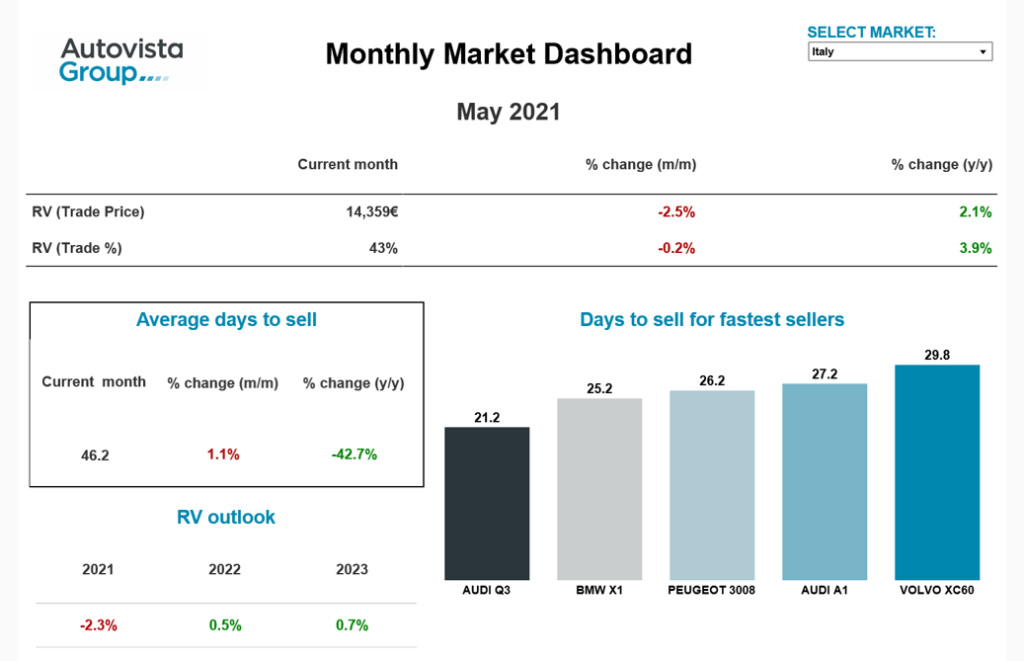
Slower rehoming in France and Italy
In addition to the RV fall in France and Italy, three-year-old cars have been slower to sell in May than April. The greatest rise in the number of stock days was in France, where used cars are taking 54.1 days on average to find a new home, 3.2% longer than last month. However, stock days fell month on month in the UK and Spain, by 3.5% and 3.8% respectively. Despite the month-on-month decline in trade prices in Germany, used cars are taking on average 53.1 days to sell, 6.3% quicker than in April.
Nevertheless, three-year-old cars are moving on far more quickly than a year ago in all the major European markets, which were only starting to emerge from their lockdowns in May 2020. The weakest improvement is in France, where the average number of days for 36-month-old cars to sell is 9.6% lower than during the same period last year. At the other end of the spectrum, three-year-old cars are selling after an average of 40.2 days in the UK, 47.3% quicker than a year ago, buoyed by the reopening of dealers from 12 April.
The Mercedes-Benz GLA in the UK was the fastest-selling car in the major European markets in May 2021, taking on average just 20.8 days to find a new home. In second place was the Audi Q3 in Italy, which is selling after an average of just 21.2 days. With COVID-19 restrictions easing since 12 April, the third fastest-selling car was in the UK too; the Range Rover Evoque is moving on in under 22 days.
Improved outlook in France
The MMD also features the latest Autovista Group RV outlook. A downward trend is still forecast in most markets in 2021, but the outlook has been revised upwards in France. RVs are now forecast to increase by 0.7% in 2021, compared to the modest decline of 0.4% that was previously anticipated.
‘The government incentive plan since 1 June, coupled with a lack of new-car production and low used-car supply, has impacted RVs positively. Diesel RVs are increasing as used-car demand remains important, accounting for 60% of total used-car sales, while the diesel share of new-car sales is only 30%. Tax changes in 2021 and 2022 – a general malus [tax penalty] increase and a malus on weight – will penalise petrol cars even more. As a result, we expect a decline in petrol sales, which would, in the end, be positive for petrol RVs too,’ explained Yoann Taitz, Autovista Group head of valuations and insights, France and Benelux.
In Spain, the resilient performance of the used-car market will not be enough to compensate for the higher economic pressure the country is facing, especially as the crucial tourism sector struggles to reboot. Nevertheless, RVs are only forecast to end 2021 down 1.1% on December 2020.
The situation is similar in Italy, but is compounded by less resilient demand for used cars, with RVs forecast to retreat 2.3% year on year in 2021. Marco Pasquetti, Autovista Group forecast and data specialist, Italy, points out that ‘even if the impact on residual values is milder in 2021 than in previous outlooks, the economic recovery will take longer than expected.’
RVs are still forecast to decline in Germany in 2021, albeit by only 0.7%, and improve slightly in the UK – aided by healthy used-car demand and even more pronounced constraints on new-car supply than in other markets.
Click here or on the screenshot above to view the monthly market dashboard for May 2021.
Hitting the target: Lone carmakers that successfully reduced their emissions
In the second part of a three-part series on meeting CO2 emissions targets, Autovista Group senior data journalist Neil, King considers the manufacturers that successfully met their respective targets without pooling emissions.
Last year was the first step for carmakers to meet strict CO2 emissions targets. Many decided to pool with other carmakers to spread their emissions over a larger fleet size. However, several carmakers chose to go it alone.
While some may have been confident in their own fleet-average emissions, there may have been other reasons behind the decision for a few carmakers. One may have been control, having no external influence on their own numbers. Another may have been down to cost.
Pooling with other manufacturers may ensure meeting the target, but requires a financial contribution to ‘partner’ companies. This financial contribution would be a waste of finances if carmakers believe they can meet their targets alone. Looking back at those who pooled, many who instigated discussions were forced into lowering their potentially fine-inducing emissions. Others were so confident they looked to help those that were struggling.
So, to recap, from 2021, the average emissions target for new cars registered in the EU is set at 95g/km CO2. For every 1g/km of CO2 a manufacturer exceeds its average emissions target by, it is fined €95, multiplied by its volume of new-car registrations in the preceding year. However, the highest-polluting 5% of new cars registered in 2020 are excluded from the 2021 fines calculations, which serves as a transitional phase for carmakers.
While carmakers do not publicise their thoughts about pooling, two that could have considered control and finances would be Daimler and BMW. Both met their respective emissions targets independently, and had financial concerns leading up to the deadline for emissions targets.
BMW beats target
BMW had set aside around €1 billion in 2019 to pay off an expected fine for its alleged part in an emissions cartel. However, the carmaker beat its 104g/km CO2 target by 5g in 2020, reducing its new-vehicle fleet emissions by 22% compared to 2019.
‘Despite the coronavirus pandemic, we delivered about a third more electrified BMW and Mini vehicles to customers than the previous year. Our plug-in hybrids were highly sought-after, as were our new fully-electric models, the BMW iX3 and Mini Cooper SE. Because we started our preparations early, we were able to significantly overfulfil our assigned CO2 limit by about 5g/km. This was never in any doubt for us. Our EU fleet emissions are currently at 99g/km, and we will also meet the 2021 requirements,’ the company stated.
A manufacturer that had a well-documented financial slide throughout 2019 and 2020 was Daimler. Therefore, going it alone made sense, maintaining control of its figures and finances – however, it was also a risk. In 2019, Daimler reported average CO2 emissions of 137g/km, way above its individual target. It reported meeting its fleet-average emissions target of 104g/km, reducing output year-on-year by 24%.
‘On the basis of WLTP, we expect our fleet average in Europe (European Union, Norway and Iceland) to decrease again significantly in 2021 compared with the figures for the previous year. This development will be driven in particular by the rising proportion of battery-electric vehicle models and plug-in hybrids in our new-car fleet,’ the company commented.
The fact that both BMW and Daimler met their targets also shows the level of commitment the carmakers put into reducing their CO2 levels. German manufacturers heavily relied on developing diesel technology in the early part of this century, relying on them to meet CO2 emissions checks. Yet the collapse of the diesel market since 2016 has meant German companies in particular have needed to speed up the rollout of hybrid (HEV), plug-in hybrid (PHEV) and battery-electric vehicles (BEVs).
Stellantis
In the first part of this series, Autovista Group noted that Fiat Chrysler Automobiles (FCA) had pooled with Tesla and successfully reduced its emissions below its individual target. Last year’s figures do not take into account the merger between PSA Group and FCA to create Stellantis. Therefore, the French partner relied solely on figures from its Peugeot, Citroen, Opel/Vauxhall and DS marques.
PSA Group did open a pool, but it only featured those brands owned by the group. Final figures were not available, but the company clarified that it had met its targets for 2020.
‘Groupe PSA remained focused on CO2 performance and met European targets in 2020, in line with prior commitments. It complied with its CO2 objectives both on the optimisation of ranges in terms of internal combustion engine (ICE) emissions and on the growth of LEV [light-electric vehicle] sales volumes (a significant increase with 120,000 registrations in 2020),’ according to the group’s financial report for 2020 (page F-48).
PSA Group’s figures will be reported alongside FCA’s in 2021, as part of the new Stellantis business. This is also likely to affect the pool FCA runs with Tesla and Honda. The Italian side of the new business may not need to rely on the zero-emission specialist carmaker to meet its targets, which would create a dent in Tesla’s finances for this year. CEO of the new manufacturing group, Carlos Tavares, has been reported to have already terminated the agreement with Tesla.
Koreans go it alone
Korean carmakers Hyundai and Kia also managed to meet their respective emissions targets on their own in 2020, with no concern voiced in the lead-up to the deadline. ‘Hyundai’s strategy towards zero-emission mobility and the high proportion of ZEVs [zero-emission vehicles] among its new-car sales were key factors enabling the company to meet its CO2 target,’ the company stated in January.
As for Kia, significant growth in demand for hybrid and electric vehicles helped the brand reduce its emissions. Electrified powertrains accounted for one in four sales in Europe last year.
‘Throughout the pandemic, we were able to continue launching new and upgraded vehicles, and continued to electrify more of our product line-up to meet growing consumer demand for advanced powertrains,’ commented Won-Jeong (Jason) Jeong, president of Kia Europe.
The work for all these carmakers is far from over. Not only do they need to ensure their full fleets meet targets by the end of 2021, but they also need to consider stricter reductions in CO2 emissions for 2025 and 2030. This is one significant reason why the number of electrically-chargeable vehicles (EVs) being manufactured is on the rise. The speed at which they need to roll out these low and zero-emission vehicles will become clearer once the final 2021 numbers are revealed.
In the first part of this series, King focused on manufacturers that successfully pooled their emissions with smaller manufacturers to meet their respective targets. The final part will look at those who missed their targets in 2020 and how they plan to meet them by the end of this year.
Schwacke Newcomer Mai 2021 – Neue Modelle im Forecast
Neue Modelle im Forecast – Nicht jeder Preis ist heiß – Masse oder Nische?
Im Mai haben wir wieder Restwertprognosen für interessante Fahrzeugneuerscheinungen in unsere Datenbank aufgenommen:
- MG EHS
- Nissan Qashqai
- Renault Arkana
- Mercedes-Benz C-Klasse
MG EHS – Weg von den Wurzeln
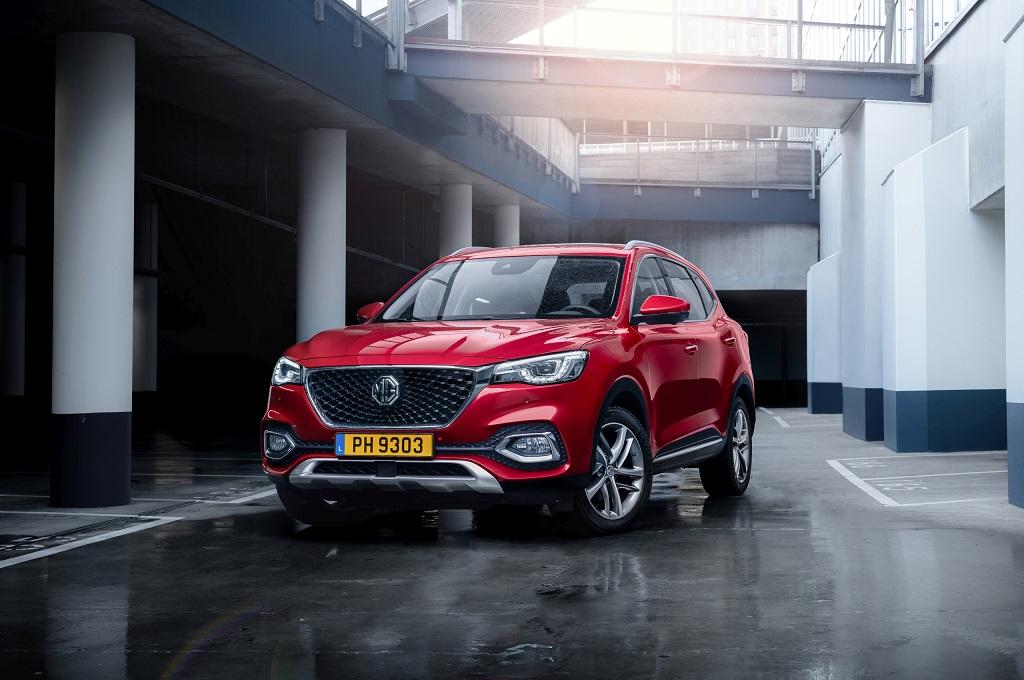
Die chinesische SAIC Motor Corporation hat für den Ausbau ihrer europäischen PKW-Präsenz mit MG einen eher kleinen Herstellernamen okkupiert. Nach den PKW der koreanischen SsangYong und der eher unscheinbaren Transportermarke Maxus erreichen mittlerweile Konzernmodelle mit diesem höchst traditionsreichen Namen die deutschen Zulassungsstellen. Die Markenrechte an den ehemaligen „Morris Garages“, die zuletzt 2002 als Teil von MG Rover mit dem Roadster MG F versuchten, Frischluftfans zu begeistern, haben sich die Chinesen 2007 durch die Übernahme des damaligen Eigentümers Nanjing Automobile gesichert. Roadster sind allerdings heutzutage keine aussichtsreichen und skalierbaren Wachstumsbringer. So war naheliegend, mit SUVs zu starten und nach dem reinelektrischen ZS folgt nun der Plug-In Hybrid EHS. Wie der ZS ist der größere EHS ein eher konservativ designter Kompakter, allerdings in der Größe eines Mazda CX-5. Dem sieht er tatsächlich insbesondere an der Front auch recht ähnlich. Preislich rangiert er ein ganzes Stockwerk tiefer und liegt mit seiner gut ausgestatteten Basisvariante Comfort sogar leicht unterhalb des Niveaus eines deutlich kleineren Renault Captur PHEVs bei gleichzeitig 100 PS mehr Systemleistung. Testfahrten zeigten allerdings antriebsseitig und von der Geräuschentwicklung leichte Schwächen. Der günstige All-in-Preis mit zwei Ausstattungslinien in Verbindung mit gefälligem Design, ganz passabler Qualität und Technik und 7 Jahren Garantie „auf Alles“ machen also das Gesamtpaket aus. Historische Anleihen oder britisches Flair darf man allerdings im neuen „Morris“ nicht erwarten. Aber die Rahmenbedingungen – insbesondere die aktuelle Umweltprämie – geben dem MG sicher mehr Marktchancen als seinerzeit Borgward, die es mit einem ähnlichen Konzept auf Dauer nicht durchhielten.
Nissan Qashqai – Darf’s ein bisschen mehr sein?
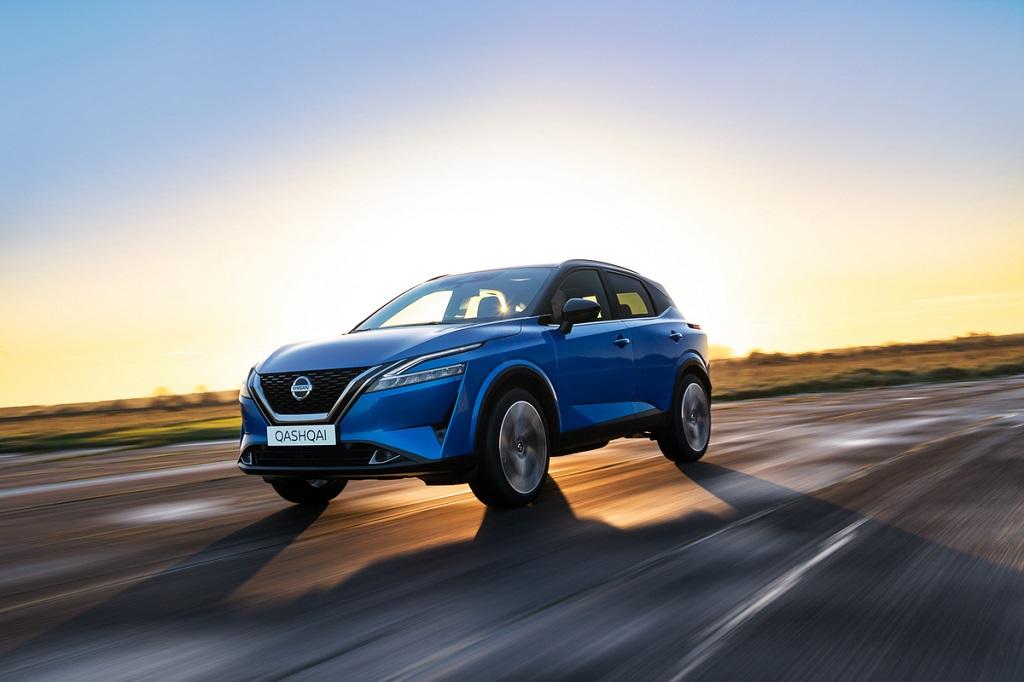
Der unangefochtene Bestseller des Brühler Importeurs hat im Laufe der Jahre reichlich Konkurrenz im Segment bekommen. War er lange Zeit hinter dem Tiguan der Vizekönig, ist er in der Zulassungsstatistik erst vom Ford Kuga, dann vom Tucson und zuletzt gar von Karoq, Ateca und Grandland X überrundet worden. Zeit also für eine Runderneuerung. Die Optik ist japanisch-dynamisch und steht zeitgemäß etwas satter, breiter und coupé-artiger auf der Straße. An das lineare Design haben sich Westeuropäer mittlerweile gewöhnt. Im Innenraum fällt das Niveau allerdings etwas ab, ist angesichts der aktuell ebenfalls recht biederen und angegrauten Wettbewerber – vom neuen Hyundai Tucson mal abgesehen – aber noch akzeptabel. Schnell veralten dürfte das Interieur allerdings, wenn in den kommenden Jahren Neuauflagen von asiatischen und europäischen Segmentbegleitern auftauchen. Bei der Preisgestaltung ist ähnlich wie bei der C-Klasse Skepsis angemahnt, ob sich die 4.000€ Mehrpreis gegenüber dem Vorgänger in angemessener Höhe im Wiederverkaufswert wiederfinden. Die Gefahr einer höheren Rabattierung des Neuwagens und nominellem Ansteigen des absoluten und relativen Wertverlustes gegenüber dem ehemaligen Listenpreis ist ein ernstzunehmendes Phänomen unserer Zeit. Die Preissteigerungen enteilen wie auch hier zu beobachten den Einkommensentwicklungen und damit den Käuferbudgets. Die Aufpreisliste ist beim Qashqai jedoch wie bereits beim Vorgänger erfreulich kurz und das meiste findet sich in gut konfektionierten Ausstattungslinien und wenigen Paketen. Wer allerdings auf die Idee kam, die Kombination aus elektrischer Heckklappe und induktiver Ladeschale hochtrabend „Business-Paket“ zu nennen, muss wohl ein womöglich pandemiebedingt beeinträchtigtes Verhältnis zu Dienstwagen haben. Interessant könnte es noch einmal werden, wenn nach den derzeit ausschließlich benzingetriebenen Motoren der e-Power genannte steckerlose serielle Hybrid im Qashqai auf den Markt kommt. Anders als üblich treibt der Verbrenner hier ausschließlich einen Generator an, der entweder die Batterie lädt, oder den relativ starken E-Motor direkt aktiviert. Der Vorteil: Das niedrigere Batteriegewicht und der beschleunigungslose und damit spritsparende Dauerbetrieb des Verbrenners sollen gegenüber normalen Vollhybriden noch einmal deutlich Verbrauch und Emissionen senken. Erzeugen aber eben auch durchgängig Motorengeräusche. Da es keinen Diesel mehr geben wird, zukünftig die einzige Antriebsalternative zu den aktuellen Benzinern mit Mildhybrid.
Renault Arkana – Einfach nur eine Crossover-SUV-Coupé-Limousine
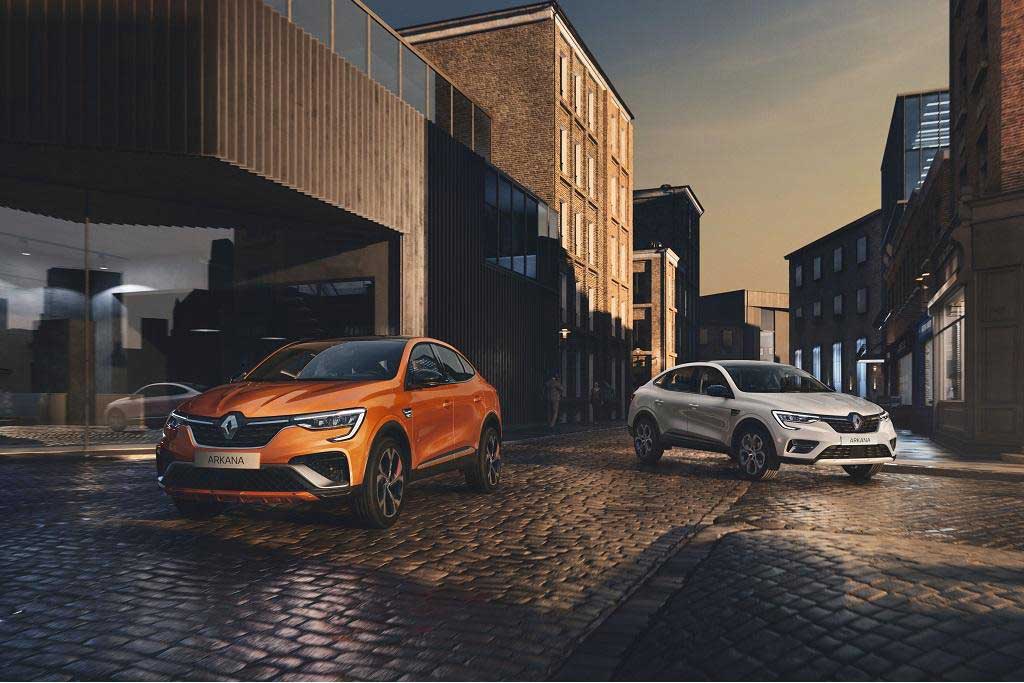
Von Renault, Nissans Nachbar in Brühl erreicht ein völlig neues Crossover-Modell den deutschen Markt – der Arkana. Von den Außenabmessungen wie Länge und Radstand ist der Neuling tatsächlich geringfügig größer als der Qashqai oder Kadjar. Er baut allerdings auf der dem Clio und Captur – oder eben dem Nissan Juke – als Basis dienenden CMF-B Plattform auf. Das sorgt auf den ersten Blick für Verwirrung und im Innenraum, besonders auf der Rückbank, angesichts der Außendimensionen für unerwartet beengte Verhältnisse. Andererseits bekommt der Arkana damit das optisch deutlich frischere Interieur seiner kleineren Geschwister mit dem großen aufrechtstehenden Touchscreen, statt des etwas in die Jahre gekommenen aus dem Kadjar. Die äußere Form nimmt dabei zwar die Designelemente vom Genspender Captur an der Front auf, ergänzt aber um eine in diesem Segment noch unübliche, hochgebockte Coupé-Limousinen-Form. Abgesehen vom Audi Q3 Sportback hat kein Modell in dieser Größenordnung einen derart ausgeprägten „Bürzel“. Allenfalls kommt einem der kürzlich vorgestellte Citroën C4 in den Sinn, der aufgrund des epischen Kampfes der Marken auf dem Heimatmarkt vielleicht der eigentliche Grund für diese Sonderform ist. Bislang sind die Erfolge von derartigen parallel angebotenen Derivaten durchwachsen. Der Audi ist da derzeit zahlenmäßig eine rühmliche Ausnahme. Ob der Arkana Kunden findet, muss sich also an anderen Dingen festmachen. Der Preis wäre beispielsweise ein Argument. Vergleicht man ihn mit dem ähnlich großen Kadjar aus demselben Hause, wird ein – günstiger – Schuh draus. Zwischen den beiden liegen durchaus vierstellige Beträge – zugunsten des Arkana! Und trotz des auf zwei Motoren beschränkten Angebots des Newcomers, ist einer davon ein Plug-In Hybrid, der beim Kadjar noch gar keine Option ist. Es gibt also gute Gründe, sich den ursprünglich für Asien und Russland entwickelten Neuzugang einmal genauer anzuschauen.
Mercedes-Benz C-Klasse – Junge, bist Du groß geworden!
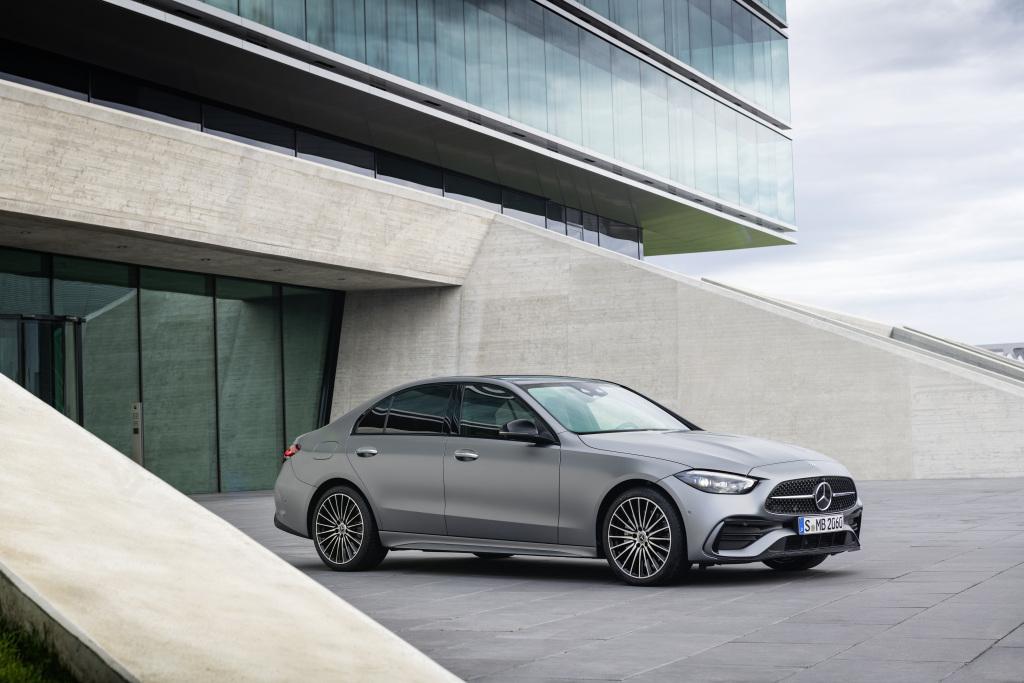
Der Urahn der heutigen mit W206 bezeichneten neuen C-Klasse wurde 1982 als 190er noch abschätzig „Baby-Benz“ genannt. Heute ist weder Babyspeck noch sonst ein Mangel an Reife zu bemerken und mehr als 30cm länger als damals ist er. Längst ist der Mittelklässler mit über einer Million der häufigste Benz auf Deutschlands Straßen und wurde erst im vergangenen Jahr durch die A-Klasse vom Stuttgarter Zulassungsthron auf den zweiten Platz verwiesen. Optisch wie gehabt eher eine Evolution, fügt sich der Neue jetzt in die Formensprache der jüngsten Modellreihen und überrascht lediglich mit einem bei Kennern vielbeachteten Detail: Der Stern ist weg! Natürlich ist das nicht generell gemeint, sondern bezogen auf das beliebte Sollbruchmitbringsel und millionenfache Ersatzteil, den „Haubenstern“. Mit dem Wegfall der Exclusive-Variante, findet sich nun bei allen Versionen der große Stern im Kühlergrill und meist eine Plakette auf der Haube. Wem dieses haptische Feature und Statussymbol zu sehr fehlt, kann sich trösten und in China die Langversion ins Auge fassen. Da findet man ihn nämlich noch an der neuen C-Klasse, einem der wenigen verbliebenen Vertreter der Generation „Kühlerfigur“. Innen ist der Kompakte nun auf der Höhe der Zeit und zeigt mit Anleihen aus der S-Klasse, was im Passat-Segment so alles möglich ist – gegen Geld natürlich. Das tablet-artige und immer volldigitale Kombiinstrument, neu gestaltete Lüftungsdüsen und das geneigte, große und hochkant eingebaute Zentraldisplay setzen einen neuen Standard bei den Premiumvertretern. Auch die Frontlichttechnik ist State of the Art und bringt wie mit der Hinterachslenkung auf Wunsch einen Hauch von S-Klasse in die Firmenwagenwelt. An die S-Klasse hat man wohl anscheinend auch bei der Preissetzung gedacht. Einen Sprung von 3.500€ Netto mehr muss das Portemonnaie oder die Ziel-Leasingrate trotz aller moderner Technik und Ausstattung erst einmal hergeben. Ob die neue aufpreispflichtige Mattlackierung selenitgrau magno eine Fuhrparkfreigabe bekommt, ist vielleicht fraglich. Wenn jetzt aber die Motorisierungen am oberen und unteren Rand der Palette, sowie Hybride und die AMG Version verfügbar werden, dann mag sich dennoch der eine oder andere Dienstwagenberechtigte Gedanken über ein Downsizing von E zu C machen. Zu dem hat er dann doch immer noch eine angemessene Preisdistanz.
Wie umweltfreundlich sind Elektroautos wirklich?
Kein Thema war im letzten Jahr präsenter als COVID-19 und noch immer hat die Pandemie die ganze Welt fest im Griff. Ein anderer bedeutender Sachverhalt, auf den Wissenschaftler und Aktivisten schon seit Jahren mit Nachdruck hinweisen, hat dadurch aber nicht an Relevanz verloren. Mit der Zunahme an Umweltschutzvorschriften und entsprechenden Auflagen durch die Politik, ist für die Autohersteller eine verstärkte Ausrichtung hin zu grüner Mobilität mittlerweile unerlässlich. Wegbereiter dieses Wandels sind die Elektroautos, die – aller Voraussicht nach – den klassischen Verbrennungsmotoren über kurz oder lang den Rang ablaufen werden. Damit diese Umstellung von Erfolg gekrönt ist, müssen die E-Modelle ihre Vorreiterrolle im Hinblick auf Umweltverträglichkeit aber erst einmal unter Beweis stellen. Sind Stromer tatsächlich so umweltfreundlich, wie es den Anschein hat? Autovista Group Daily Brief Journalist Tom Geggus hat versucht, diese Frage zu beantworten.
Laut EU-Kommission zeichnen PKWs für rund 12% des gesamten CO2-Emissionsaufkommens in der EU verantwortlich – was die Automobilindustrie unfreiwillig in den grünen Blickpunkt rückt. Das Ergebnis einer kürzlich durchgeführten Umfrage in 15 europäischen Städten hat gezeigt, dass sich knapp zwei Drittel der dort lebenden Personen für die Einführung eines Verkaufsverbots für neue Benzin- und Dieselfahrzeuge bis zum Jahr 2030 aussprechen. Auch Fahrzeughersteller und Mobilitätsanbieter befürworten einen schnelleren Übergang hin zu emissionsfreien Beförderungsmöglichkeiten. Eine Reihe von Unternehmen, darunter Volvo Cars, Uber und Lease Plan, fordert eine Einstellung des Handels mit neuen Verbrennern bis spätestens 2035. Die Folge wäre ein Mangel in diesem Fahrzeugsegment, der durch Elektrofahrzeuge abgedeckt werden müsste.
Wenn man nun aber einmal den gesamten Lebenszyklus eines Stromers betrachtet: Ist E-Mobilität tatsächlich so viel umweltfreundlicher als Benzin oder Diesel?
Ein deutlich kleinerer Fußabdruck
Eine im letzten Jahr veröffentliche Forschungsarbeit der Universitäten von Cambridge, Exeter und Nijmegen hat gezeigt, dass in 95% der Welt ein elektrisch angetriebenes Auto eine deutlich geringere CO2-Bilanz aufweist als eines, das mit fossilen Treibstoffen läuft. Dr. Florian Knobloch, Fellow der University of Cambridge, Leitautor der Abhandlung und darüber hinaus in beratender Funktion auf Bundesebene tätig, hat mit dem Team des Autovista Group Daily Brief über seine Ergebnisse gesprochen.
Das wissenschaftliche Team um Dr. Knobloch hat umfassende Untersuchungen zum Emissionsausstoß eines Fahrzeugs während seines gesamten Lebenszyklus‘ vorgenommen, sowohl in der Nutzungsphase als auch in Bezug auf Produktion und Abfallverwertung. „Während des Produktionsprozesses [des Elektroautos] ist der Verbrauch an Energie und Material auf Grund der Batterie erheblich größer“, so die Erkenntnis von Knobloch. Diese höhere Belastung gleicht das Fahrzeug in seiner aktiven Nutzungsphase dann jedoch durch einen deutlich geringeren CO2-Ausstoß wieder aus.
„Die Aussage, dass E-Autos höhere Emissionen verursachen, ist nicht korrekt – selbst dann, wenn man den gesamten Lebenszyklus des Automobils mit einbezieht“, so Knobloch weiter. „In den meisten Teilen der Welt verringern Elektroautos bereits jetzt den CO2-Fußabdruck, auch unter Einbeziehung sämtlicher Faktoren, von der Produktion bis zu Wiederverwertung.“
“Ein Schneeballeffekt”
Bei einer Einteilung der Welt in 59 Regionen, so ein Ergebnis der Studie, sind in 53 davon E-Autos bereits jetzt emissionsärmer unterwegs als Benzin- oder Dieselfahrzeuge, so unter anderem in Europa, den USA und China. Die Forschungsarbeit zeigte weiterhin, dass in Ländern wie Frankreich oder Schweden, wo ein Großteil des Stroms durch erneuerbare Energien oder nukleare Quellen gewonnen wird, der Emissionsausstoß bezogen auf den gesamten Lebenszyklus des Elektrofahrzeugs sogar rund 70% niedriger liegt als bei Benzinern. In Ländern wie beispielsweise Polen, in denen sich bislang ein Großteil der Stromerzeugung auf Kohlekraftwerke konzentriert, stellt sich die Situation derzeit noch anders dar.
Mit dem geplanten Ausstieg aus dem Kohleabbau und der daraus resultierenden Reform der Stromnetze wird aber wohl auch in diesen Regionen der Wandel in Richtung „saubere“ Energie einen Schub erhalten. Wenn also E-Mobilität zunehmend an Effizienz gewinnt, wird sie den Verbrennungsantrieb, der wiederum seinen Spitzenwirkungsgrad annähernd erreicht hat, schlussendlich überflügeln. Dr. Knobloch führt weiterhin an, dass auch die Einbindung fortschrittlicher Technologien wie Biotreibstoffe vermutlich eher nicht dazu führen werde, den CO2-Fußabdruck von Verbrennern maßgeblich zu verkleinern.
Die Umstellung auf E-Mobilität braucht Zeit und das Zutrauen in die neue Technologie muss wachsen, bis schließlich die breite Masse erreicht wird. „Jedes Elektroauto, das derzeit bereits auf dem Markt ist, erhöht die Wahrscheinlichkeit, dass die Verkaufszahlen in diesem Segment auch zukünftig steigen“, erläutert Dr. Knobloch. Mit dem zunehmenden Angebot an Stromern, wächst die Akzeptanz und damit auch das Vertrauen in die Technik – ein Schneeballeffekt, der dazu führt, dass sich immer mehr Menschen für diese Form der Mobilität entscheiden. Die Studie prognostiziert, dass bis zum Jahr 2050 rund die Hälfte aller Autos weltweit elektrisch fahren wird. Die Folge wäre eine Verminderung der globalen CO2-Emissionen von bis zu 1,5 Gigatonnen pro Jahr.
Antriebsarten im Vergleich
Die in Europa ansässige Initiative Transport and Environment (T&E), deren Mitglieder sich unter anderem für die Entwicklung klimaneutraler Mobilitätssysteme einsetzen, legt Werte vor, die zeigen, dass der CO2-Ausstoß von Elektroautos im Durchschnitt knapp dreimal niedriger ist als der ihrer „Kollegen“ mit Verbrennungsmotoren. In diesen Zahlen sind Faktoren wie die Rohstoffbeschaffung für die Batterie, Stromerzeugung und sogar die Errichtung von Kraftwerken bereits berücksichtigt. Um den Emissionsunterschied zwischen den Elektro- und Verbrennungsmotoren während des Lebenszyklus‘ eines Fahrzeugs besser darstellen zu können, hat T&E ein Tool zum Vergleich von Antriebsarten entwickelt. Hier werden beispielsweise Produktionsjahr, Fahrzeuggattung und Herstellungsort sowie der Energieverbrauch, der für die Fertigung der Batterie benötigt wird, gegenübergestellt.
Im Gespräch mit Autovista Group Daily Brief erklärte T&E Manager Lucien Mathieu, verantwortlich für die Bereiche Straßenfahrzeuge und E-Mobilitätsanalyse und Urheber des Analysewerkzeugs, dass das Tool dabei helfen soll, bestehende Vorurteile gegenüber der Emissionsproduktion von Elektroautos auszuräumen. Häufig, so die Aussage Mathieus, liegen diesen Analysen veraltete Daten zugrunde, besonders im Hinblick auf die schnell voranschreitende Entwicklung bei elektrisch angetriebenen Fahrzeugen. Basierend auf aktuellen Informationen ermittelt das Tool von T&E den CO2-Ausstoß pro Kilometer bzw. pro Tonne über den gesamten Lebenszyklus eines Fahrzeugs.
Vergleicht man beispielsweise zwei im Jahr 2020 gekaufte Mittelklassewagen miteinander, kommt man auf einen Emissionswert von 90 Gramm CO2 pro Kilometer für das Elektroauto, gegenüber 253 Gramm beim Benziner. Zieht man also die Tonnen von Kohlendioxid in Betracht, die ein PKW über Jahre und weite Strecke hinweg produziert, dann ist die „CO2-Verschuldung“, die bei der Produktion des E-Fahrzeugs entstanden ist, aufgrund der niedrigen Verbrauchswerte relativ schnell wieder ausgeglichen. Der Unterschied zum Verbrennungsmotor, der in der Energieumsetzung weit weniger effizient arbeitet, ist immens.
Diese Ungleichheit wird sich durch die stetige Verbesserung der Batterietechnik noch vergrößern, während im Vergleich dazu die mit fossilen Brennstoffen angetriebenen Fahrzeuge ihren Spitzenwirkungsgrad nahezu erreicht haben. Eine Studie von T&E kam kürzlich zu dem Ergebnis, dass eine E-Auto-Batterie unter Einbeziehung der Recyclingmöglichkeiten rund 30 Kilogramm Rohstoffe verbraucht. Im Vergleich dazu steht ein durchschnittlicher Treibstoffbedarf von 17.000 Litern bei einem regulären Verbrenner.
“Die wertvollen Minerale, die für die Produktion der Batterien abgebaut werden, können, im Gegensatz zu Mineralöl, wiederverwertet werden“, so die Aussage von Greg Archer, UK Direktor von T&E. Archer weiter: „Im Laufe seines Lebenszyklus‘ verbraucht ein klassischer Verbrennungsmotor im Durchschnitt eine Ölmenge, die, in Fässern aufeinandergestapelt, einer Höhe von 25 Stockwerken entspricht. Dabei produziert er rund 40 Tonnen CO2, was einen erheblichen Beitrag zur globalen Erwärmung darstellt. Im Vergleich dazu verliert man beim Recycling-Vorgang einer elektrischen Autobatterie nur rund 30 Kilogramm an metallischen Materialien –ungefähr die Größe eines Footballs.“
Diese Diskrepanz wird in den nächsten zehn Jahren noch zunehmen, wenn es durch die Weiterentwicklung der Prozesse gelingt, die Lithiummenge, die für die Batterieproduktion benötigt wird, zu halbieren. Darüber hinaus wird die erforderliche Menge an Kobalt voraussichtlich auf ein Viertel des jetzigen Verbrauchs sinken, der Bedarf an Nickel vermindert sich wohl immerhin um rund ein Fünftel. Außerdem profitieren Stromer auch von technologischen Entwicklungen außerhalb ihres eigenen Segments.
Um den Fortschritten im Bereich E-Mobilität Rechnung zu tragen, plant T&E die regelmäßige Aktualisierung der für das Tool verwendeten Daten. Darüber hinaus sollen auch Plug-in Hybride (PHEVs) in die Bewertung aufgenommen werden, um so das Anwendungsgebiet zu erweitern.
Autos unter Strom
Mehr als 3.500 Energieunternehmen, die Eurelectric angehören, einem Branchenverband der europäischen Elektrizitätswirtschaft, haben sich Ende letzten Jahres für eine Reduktion der Treibhausgasemissionen um mindestens 55% bis 2030 ausgesprochen. Bei einer steigenden Anzahl an Energieversorgern und -erzeugern, die grünere Lösungen befürworten – dazu zählt auch der vermehrte Einsatz von erneuerbaren Energien – ist die logische Folge, dass auch Elektronautos klimaneutraler werden.
Petar Georgiev, Leiter des Bereichs Klima- und E-Mobilität bei Eurelectric, hat im Gespräch mit Autovista Group‘s Daily Brief darauf hingewiesen, dass es gerade in Bezug auf E-Mobilität von erheblicher Bedeutung sei, die übergeordneten Zusammenhänge im Blick zu behalten. „Sie müssen auch die Entwicklung der CO2-Fußabdrücke in den verschiedenen Ländern und während unterschiedlicher Zeiträume betrachten – vor allen Dingen, wie diese sich verändern. Wir im Energiebereich sehen eine deutliche Tendenz hin zu einer zunehmend grüneren Stromversorgung“, so die Aussage von Georgiev. „Wenn wir aber warten, bis wir ein vollständig auf erneuerbarer Energie basierendes Stromnetz etabliert haben und erst dann in die Nutzung einsteigen, wird sich das vermutlich als großer Fehler erweisen.“
Eurelectric hat kürzlich die Elektrifizierung der Fahrzeugflotten in Europa als einen entscheidenden Faktor für umweltverträgliche Mobilität in den kommenden zehn Jahren genannt. Die Gesamtgröße der Fahrzeugflotten in Europa liegt bei rund 63 Millionen Autos, Transportern, Bussen und LKWs, die entweder von Privatunternehmen oder von staatlichen Behörden betrieben werden. Laut einer Erklärung des Verbandes sind diese Fahrzeuge, obwohl sie nur rund 20% des Gesamtvolumens ausmachen, für 40% aller gefahrenen Kilometer verantwortlich und darüber hinaus für 50% der CO2-Emissionen im Bereich Transport. „Die Elektrifizierung der Fahrzeugflotten kann die Wende bringen“, sagt Kristian Ruby, Generalsekretär bei Eurelectric. „Neben einem deutlich verringerten Kohlendioxidausstoß sorgt sie gleichzeitig für eine Reduzierung der Total Cost of Ownership. Also eine Win-win-Situation für alle – für die Flottenmanager und auch für die Gesellschaft als Ganzes.“
Die Elektrifizierung von Fahrzeugen verfügt – abhängig von ihrem Einsatz – über ein enormes Potential, den CO2-Fußabdruck maßgeblich zu verringern. Wenn wir nun also auf unsere Eingangsfrage zurückkommen: „Sind Stromer tatsächlich so umweltfreundlich, wie es den Anschein hat?“, dann lautet die Antwort „Ja“ – aber der Erfolg hängt maßgeblich davon ab, wie schnell sich die Technologie in den kommenden Jahren in der Breite durchsetzt.
Quelle:
Autovista Group News & Insights: Daily Brief – Are EVs as green as they seem?
Schwacke Insights Mai 2021 – monatliche Kennzahlen im Überblick
Im April zog das Gebrauchtwagengeschäft wieder merklich an. Das fast ausgeglichene Mengensaldo beschert geringen Preisdruck und insgesamt eine leichte Aufwärtstendenz durch Zulauf wertstabiler
Fahrzeuge und optimistischer Einpreisung. Die Prognosen liegen weiterhin im Minus aufgrund der Talfahrt des Preisniveaus der vergangenen Jahre. Da reguliert sich erst langsam das Gefüge zwischen aktuellem Preisniveau und Vorausschau. Im Bereich der Elektro-Antriebe sind in diesem Alterssegment kleine Mengen am Markt, die ab 2022 deutlich und dann rasant anwachsen werden. Die aktuelle Preissituation ist also noch nicht von Volumen aber von günstigen Neu- und jungen Gebrauchtwagen beeinträchtigt. Saisongemäß kommt mit dem Beetle nun auch ein Cabrio in die TOP 5 der Schnelldreher. Es finden Cayenne Diesel zügig Käufer – insbesondere, weil diese Antriebsart in 2018 eingestellt wurde.
Podcast: Carmakers take aim at electrification targets
Carmakers are taking aim at electrification targets. Some manufacturers have laid out ambitious plans, while others are making more gradual transitions. Autovista Group Daily Brief journalist Tom Geggus discusses these targets with editor Phil Curry and senior data journalist Neil King.
You can listen and subscribe to receive podcasts direct to your mobile device, or browse through previous episodes, on Apple, Spotify, Google Podcasts and search for Autovista Group Podcast on Amazon Music.
Show notes
Stellantis targets 70% electrified-vehicle sales in Europe in 2030
Volvo to go all electric and online by 2030
Honda targets 100% BEV and hydrogen sales with improved carbon-neutrality
Renault aims to achieve European carbon neutrality in 2040
Can the automotive industry carve out a sustainable future?
Are EVs as green as they seem?
VW outlines large-scale energy production as part of carbon-neutrality plans
VW accelerates towards electric and digital future
The EU big four new-car markets deteriorate in April
Autovista Group senior data journalist Neil King explores the significance of the downturns in the EU’s four largest markets in April 2021, compared to April 2019.
New-car registrations in France, Germany, Italy and Spain continue to struggle to find a way out of the fallout from the COVID-19 pandemic. All four markets suffered double-digit declines in April, compared to 2019 figures. Moreover, the contractions were even more pronounced than in March, with all markets going into reverse.
As COVID-19 lockdowns decimated dealer activity in April 2020, the extraordinary year-on-year growth rates are meaningless. Therefore, this article focuses on more meaningful comparisons with 2019, which give a better representation of the performance of new-car markets.
France SAAR at lowest level since November
According to the latest data released by the CCFA, the French automotive industry association, only 140,426 new cars were registered in France in April. This is far below the average of 175,000 registrations for the month between 2010 and 2019. Compared to 2019, the market contracted by more than a quarter in April and is one fifth smaller in the year-to-date. Moreover, the seasonally-adjusted annualised rate (SAAR) of the French market fell to 1.63 million units last month – the lowest level since November, when dealers were closed for most of the month.
‘We are now starting to have delivery problems due to the great shortage of electronic components,’ commented CCFA spokesperson François Roudier. Component shortages have disrupted production at some car plants, including a three-week production stoppage of the new Peugeot 308 at Sochaux, the CCFA noted.
Although dealers have remained open in France, some sales channels continue to struggle because of restrictions in the country. For example, short-term rental companies have registered fewer cars ‘since people do not go on vacation and there is no business travel either,’ underlined Roudier.
The French new-car market faces another challenge later in the year as incentives for battery-electric vehicles (BEVs) will be reduced by €1,000 from 1 July. Assuming no further COVID-19 restrictions on dealerships in France, Autovista Group forecasts that the new-car market will grow by 8% in 2021, following the 25% contraction in 2020, to close to 1.8 million units. This is a slight downward revision of the 10% growth previously forecast by Autovista Group for 2021, and is 19.5% lower than the volume of cars registered in pre-crisis 2019.
Second-lowest April volume in reunified Germany
New-car registrations in Germany amounted to 229,650 units in April, equating to a decline of 26.1% compared to the same month in 2019, according to the latest figures released by the Kraftfahrt-Bundesamt (KBA). With the conditional reopening of dealerships in Germany since 8 March, the new-car market appeared to be on the slow road to recovery. However, the level of registrations retreated in April as the country battled against stubbornly consistent COVID-19 infection rates.
Autovista Group calculates that the SAAR of the market plummeted to 2.5 million units in April – the lowest level since June 2020. Furthermore, the German automotive industry association VDA highlighted that ‘the car market in April 2021 represents the second-lowest market volume for April in reunified Germany.’
In the first four months of 2021, the poor performance in April brought the year-to-date contraction, compared to the same period in 2019, down to 25.6%. In this context, and with no dramatic improvement in the vaccination rollout and the number of COVID-19 cases, the recovery of the German market will come later than previously anticipated. Accordingly, Autovista Group has reduced its forecast for 2021 to 3.06 million new-car registrations, up just 5% on 2020 and 15% lower than 2019.
Italy’s ‘gradual restart is backing down’
In Italy, the industry association ANFIA reports that, compared to April 2019, the new-car market contracted by 17.1%. Similarly, registrations were 16.9% lower in the year-to-date than in the first four months of 2019. Furthermore, the weaker comparison to 2019 than in March suggests that ‘the gradual restart of the market, with incentives for cars in the 61-135g/km range of CO2 emissions, is backing down,’ said Paolo Scudieri, president of ANFIA.
‘The priority at the moment is, therefore, the refinancing of the support measures for car demand, but also for light-commercial vehicles. These measures pay for themselves in a short time, with additional cash for the state, and represent investment in the modernisation of the fleet, by putting latest-generation vehicles on the road. This is an indispensable intervention to support a sector that guarantees employment and economic growth, and which is experiencing a particularly difficult phase also due to international crisis factors such as the problems of supplying microchips,’ he added.
As it stands, the government incentives are in place until at least the end of June. Assuming there are no COVID-19 restrictions on Italian dealerships in 2021, Autovista Group forecasts that the market will grow 17% year on year in 2021, to over 1.6 million units. This is a higher growth rate than in France, but Italy starts from a weaker base, with registrations down 28% in 2020. Nevertheless, the market would still be 15.7% down on the 2019 level.
Long way from recovery in Spain
In Spain, 58,279 new cars were registered during April, according to ANFAC, the Spanish vehicle manufacturers’ association. The market continues to contract compared to the pre-COVID-19 levels of 2019. There was a greater decline in April (down 34.2%), than in March (down 30%). In the first four months of 2021, 39.3% fewer cars were registered than in the same period in 2019.
April closed ‘one of the worst four-month periods since the last years of the economic crisis,’ the industry body commented. Fewer than 265,000 new cars were registered between January and April 2021, compared to over 300,000 units in the May-August and September-December periods in 2020.
‘The pandemic, the uncertainty about vaccination and successive waves, the lack of tourism, the economic crisis, the lack of aid to demand and the registration-tax rise continue to affect the market,’ ANFAC added.
Juan Luis Fernández, head of public affairs at the Spanish association Faconauto, noted; ‘We are a long way from recovery: we continue to lose units month after month with no hope or changes in the short term. In this scenario of a health crisis, which logically has a negative impact on consumption, there are two worrisome points; how relegated the private channel is being, which only accounts for four out of every 10 sales, and the delay in the arrival of vehicles to dealerships because factories are very affected by the lack of semiconductors for their production.’
‘The uncertainties are greater than the certainties’
Spain introduced the new MOVES III incentive scheme for electrically-chargeable vehicles (EVs) on 10 April 2021, which includes hydrogen fuel-cell vehicles (FCEVs) for the first time. However, ‘in the absence of being able to assess the scope of the incentives for electrified vehicles in the market, as well as the arrival of the long-awaited recovery, a few very committed months await us for the sector, where the uncertainties are greater than the certainties,’ Fernández explained.
‘For all this, a strategic plan for the sector is urgently needed, in which the government and the employers‘ associations work to try to reverse this situation,’ he concluded. Without an improvement in consumer confidence, a return of tourism, and/or new measures to stimulate new-car demand, the Spanish market will continue to struggle. Autovista Group maintains its forecast that demand will recover from the 32% loss in 2020, albeit only by 6% to about 900,000 units in 2021. Moreover, at this level, the Spanish market will be 28.3% smaller this year than in 2019.
Launch Report: Can the VW ID.4 compete on range, charging time and price?
The Volkswagen (VW) ID.4 is one of the first battery-electric vehicles (BEVs) in the C-SUV segment, with limited competition as premium brands predominantly focus on higher segments. The exterior design is neutral and conservative, but the model is still a likeable fully-electric SUV that is arguably more appealing than its smaller sibling, the ID.3, in terms of looks, value and usability.
The interior is modern and airy, offering roominess comparable to vehicles in higher segments, with especially good legroom in the rear. With room for five adults and a boot capacity of 543 litres, it should meet the practical needs of most consumers. The overall impression of interior quality is lower than for other VW models, but is a slight improvement on the ID.3.
The ID.4 has a good level of standard equipment, but very few available options. Nevertheless, the augmented-reality head-up display is a technological highlight, and the limited options packages will generally produce well-equipped used cars.
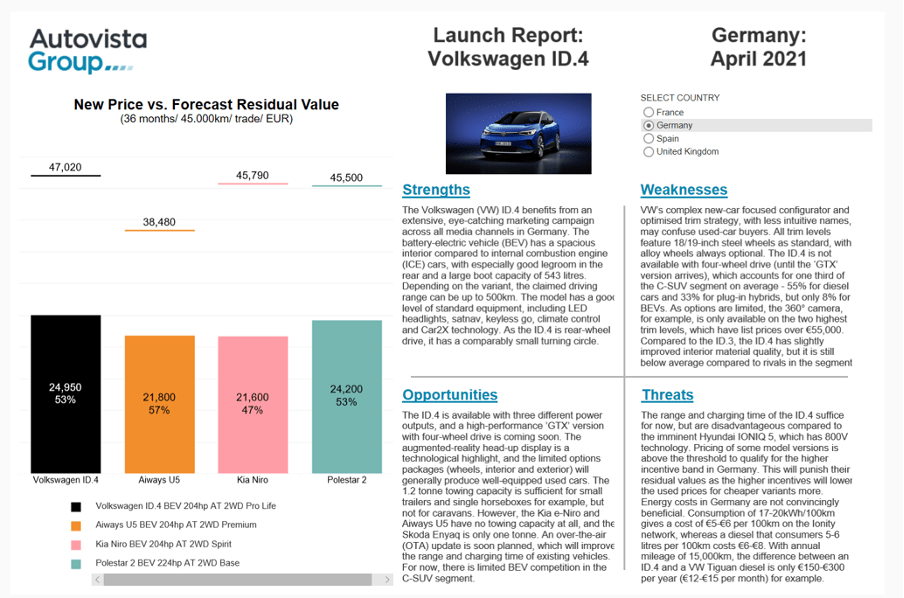
Three different power options, and several trim levels, enable the ID.4 to appeal to a wide range of customers with different budgets. The two-tonne weight does mean performance is only average for a BEV, but a high-performance ’GTX’ version with four-wheel drive is coming soon.
Depending on the variant, the claimed driving range can be up to 500km, which should cover most needs. However, electricity consumption is higher (23 kWh/100km) than announced (19 kWh) and is especially high on motorways. Hence, the real range is closer to 380-400km. A wall box is highly recommended too, as the car requires two days to charge with a standard plug. Nevertheless, the range and charging time of the ID.4 are competitive for now and with over-the-air (OTA) updates planned, both will improve.
The addition of the ID.4 to VW’s line-up will help the manufacturer meet its CO2 emissions targets. With the Tiguan available with diesel, petrol and plug-in hybrid (PHEV) powertrains, the fully-electric ID.4 means VW is now offering a full range of engines in the compact SUV segment.
List prices are comparatively high, although this is slightly compensated for by the level of standard equipment. As with all BEVs, there are concerns about where the ID.4 will fit into the used-car market once they start to come back in any volume. There remains a large price gap compared to internal combustion engine (ICE) vehicles, and surging demand is mounting pressure on the residual values of BEVs.
Click here or on the image above to read Autovista Group’s benchmarking of the Volkswagen ID.4 in France, Germany, Spain and the UK. The interactive launch report presents new prices, forecast RVs and SWOT (strengths, weaknesses, opportunities and threats) analysis.
What is total cost of ownership?
What is total cost of ownership (TCO)? Daily Brief editor Phil Curry explains the terminology and its importance as a cost-comparison tool.
To get notifications for all the latest videos, you can subscribe for free to the Autovista Group Daily Brief YouTube channel.
Are EVs as green as they seem?
The last year has been dominated by a single health emergency that brought the world to its knees. But for decades, scientists and campaigners have been warning of another impending crisis. As governments put environmental regulations in place, carmakers are transitioning into clean mobility companies. Spearheading this change, electrically-chargeable vehicles (EVs) appear poised to take the helm from internal combustion engines (ICEs). But for this handover to work, these electric models must prove to be environmentally advantageous. Autovista Group Daily Brief Journalist Tom Geggus asks, are EVs as green as they seem?
According to the European Commission, passenger cars are responsible for around 12% of total EU CO2 emissions, putting the automotive industry in the green spotlight. A poll of 15 European cities recently revealed nearly two-thirds of urban residents back a ban on the sale of new petrol and diesel cars by 2030. OEMs and mobility providers are also supporting a faster transition to zero-emission transport. Volvo Cars, Uber and LeasePlan are among a group of companies calling for an end date to new combustion car purchases in Europe no later than 2035. This would leave a large ICE-sized hole for EVs to plug. But considering its entire lifetime, is an electrified vehicle that much cleaner than a petrol or diesel-powered one?
Significantly smaller footprint
Published in March last year, research from the universities of Cambridge, Exeter and Nijmegen showed that in 95% of the world, an electric car has a significantly smaller carbon footprint than one powered by fossil fuels. Dr Florian Knobloch, University of Cambridge fellow, German Federal Ministry policy advisor, and the paper’s lead author, spoke with Autovista Group’s Daily Brief about the findings.
The academic team carried out extensive life-cycle assessments of emissions produced through vehicle use, as well as production and waste processing. ‘When you look at the production stage, it takes significantly more energy and material input due to the battery,’ Dr Knobloch said. But the EV then makes up for this larger burden across its entire lifetime thanks to far lower running emissions.
‘It is a myth that electric cars do increase emissions, even on a lifetime basis,’ he said. ‘In most parts of the world already, today EVs will decrease emissions, even if you factor in everything from production to recycling.’
‘A snowball effect’
When dividing the world into 59 regions, the research revealed that in 53, electric cars are already less emissions-intensive than one powered by petrol or diesel. These regions include Europe, the US and China. In fact, lifetime emissions from EVs were found to be 70% lower than petrol cars in countries like France and Sweden, where large amounts of electricity are generated through renewable and nuclear sources. However, the same cannot be said for counties like Poland, where dependence on coal-fuelled power stations lingers.
But as grids worldwide are rewired with decarbonisation in mind, even these regions will see more reason to go electric. So, as EVs become increasingly efficient, they will outstrip ICEs which have already reached near-peak efficiency. Dr Knobloch points out that even with the inclusion of greener technology like biofuels, there is little chance for the carbon footprint of ICE vehilces to greatly improve.
This transition to electromobility does take time. Confidence in EVs still needs to build up: from the early adopters to the mainstream. ‘Every EV you buy now increases the chance of more EVs being bought in the future,’ Dr Knobloch explained. As consumers are exposed to an increasing number of EVs, a snowball effect will take place with confidence growing alongside adoption, encouraging more people to take the electric leap. The study projects that globally, half of cars on average could be electric by 2050. This would lower global CO2 emissions by up to 1.5 gigatons annually.
A comparative tool
In Europe, clean-transport campaign group Transport and Environment (T&E), found that electric cars emit on average almost three times less CO2 than their ICE equivalent. Again, this figure considers wider impact, including the sourcing of battery materials, electricity production, and even power-plant construction. To illustrate the difference between the lifetime emissions of EVs and ICEs, T&E created a tool to compare drive types, considering the year of purchase, vehicle type and location, as well as electricity used for battery production.
Lucien Mathieu, manager overseeing road vehicles and e-mobility analysis at T&E, spoke with Autovista Group’s Daily Brief. As the tool’s creator, he explained it aims to combat other bias analysis of electric-car emissions, that might rely on outdated data, particularly given the rapid advance of EV technology. Using the most up-to-date information, T&E’s tool reveals CO2 emissions per kilometre, as well as in tonnes over lifetime.
For example, comparing two medium-sized cars bought in 2020, T&E’s tool reveals the electric car, on average, is responsible for 90 grammes of CO2 per kilometre versus petrol with 253 grammes. Considering tonnes of CO2 over distance driven, the EV’s ‘carbon debt’ from production is paid off quite quickly thanks to its low-usage emissions. This compares starkly to an ICE car, which is far less efficient when converting its fuel into movement.
This canyon between EV and ICE only looks set to grow as battery technology continues to advance, while fossil-fuel cars have already achieved close to their peak efficiency. A T&E study recently calculated that an EV battery uses 30 kilograms of raw materials with recycling, compared to the 17,000 litres of petrol burned by the average car.
‘The valuable minerals mined to make electric-car batteries will be used and reused unlike those of oil,’ said Greg Archer, UK director of T&E. ‘Over its lifetime, an average-engined car would burn through a stack of oil barrels, 25 storeys high, creating about 40 tonnes of CO2 and worsening global warming. In comparison, only 30 kilograms of metals would be lost each time an electric-car battery is recycled – roughly the size of a football.’
This gap will increase as advancements drive down how much lithium is needed to make a battery by half over the next decade. Cobalt will drop by over three-quarters and nickel by around a fifth. So, as EVs develop, T&E plans to keep their tool updated with the latest available evidence, as well as expanding its scope to include plug-in hybrids (PHEVs). But of course, EVs also benefit from technologies developing outside of their own powertrains.
Powering vehicles
At the end of last year, more than 3,500 European power companies, represented through the federation for the European electricity industry, Eurelectric, came out in support of a minimum 55% reduction in greenhouse gas emissions by 2030. As more electricity generators and distributors throw their weight behind cleaner-energy solutions, including the use of more renewables, EVs can be expected to become greener.
Speaking with Autovista Group’s Daily Brief, Petar Georgiev, climate and E-mobility lead at Eurelectric, pointed to a larger picture when considering the energy behind EVs. ‘You do have to keep in mind what the actual carbon footprint is in different countries, at different times, and also how it is changing, because for us in the power sector, we clearly see that the grid is becoming cleaner and cleaner,’ he said. ‘But if we have to wait to have a fully renewable grid, and then only start to integrate renewables, that would probably be a very big mistake.’
Because an EV’s CO2 levels can be lowered long before its first charge, it makes sense to take a holistic approach to EV emissions and electricity usage. For example, manufacturers can opt for more efficient production methods, even incorporating renewables into the process. Furthermore, which cars plug into electromobility will be hugely important.
Eurelectric recently identified the electrification of Europe’s vehicle fleets as a ‘catalyst for clean mobility throughout the 2020s.’ The continent’s fleet is made up of 63 million cars, vans, buses, and trucks, operated by private companies or public authorities. The federation explained, however, that despite only making up 20% of the parc, these vehicles account for 40% of all kilometres travelled. They also account for 50% of CO2 emissions from transport. ‘Electrification of car fleets can be a real game-changer,’ Kristian Ruby, secretary-general of Eurelectric said. ‘It comes with tangible reductions of total costs of ownership and CO2 emissions. So, it is a good deal both for fleet owners and society at large.’
While the electrification of vehicles contains the potential to reduce CO2 emissions dramatically, it is enormously dependent upon usage. So, when asked, ‘are EVs as green as they seem?’ the answer is yes, but adoption rates will determine their success.
Schwacke Insights Q1 2021 – Zulassungen aus Restwertsicht
Der Markt ist Lockdown-bedingt im ersten Quartal deutlich unter den Vorjahren, aber mit Besonderheiten. So scheinen die Flottenzulassungen in Summe nahezu unbeeindruckt, offenbaren aber im Treibstoffmix die Dramatik. Durch enormes Wachstum wurden wie erstmalig im letzten Quartal mehr elektrifizierte Antriebe zugelassen als Benziner und müssen 2023-2025 gebraucht vermarktet werden. Und Mildhybride zählen nicht mal dazu. Bei den kurzfristigen Remarketing-Kanälen Handel, Hersteller und Vermieter sieht der Elektroschub ähnlich aus, reicht aber lang nicht, um auf das ohnehin niedrige Vorjahresniveau zu kommen. Händler und Hersteller folgen dem starken Trend zwar mit mehr E-Modellen, aber längst nicht so stark wie die mehrfach profitierenden Dienstwagenfahrer und Flottenbetreiber. Es bleibt weiterhin die dringende Aufgabe, die Nachfrage nach gebrauchten E-Fahrzeugen zu stimulieren.
Schwacke Insights April 2021 – monatliche Kennzahlen im Überblick
2021 zeigt weiterhin den Einfluss der Pandemie. Nach zwei schwachen Monaten sind im März Verkäufe wieder stark angezogen. Das aktuelle Bewertungsniveau ist aufgrund des geringen Bestandes insgesamt stabil bis leicht positiv. Die Prognosen folgen noch der Negativentwicklung des vergangenen Jahres. Auch Standzeiten sind bei Verbrennern vorteilhaft, was nicht zuletzt im nachlassenden Nachschub vergangener Jahre begründet liegt. Elektrifizierte Antriebe kämpfen dagegen in nahezu allen Parametern durch den andauernden prämienbedingten Neuwagenboom. Neu bei den Kurzstehern: Cayenne Diesel profitieren von Porsches Abkehr von Selbstzündern. Beim BMW i3 kommt nun das Facelift und die ‚s‘-Versionen zum Tragen. Die Smart-Benziner haben sich nicht signifikant verbessert, profitieren aber davon, dass frühere Schnelldreher in zu geringer Menge verkauft wurden, um ins Ranking zu kommen.
Schwacke Newcomer April 2021 – Neue Modelle im Forecast
Neue Modelle im Forecast – Fortschritt durch Vielfalt – No Mainstream Please
Im April haben wir wieder Restwertprognosen für interessante Fahrzeugneuerscheinungen in unsere Datenbank aufgenommen:
- Audi e-tron GT
- Subaru Outback
- Dacia Sandero
Audi e-tron GT – Back to the Future
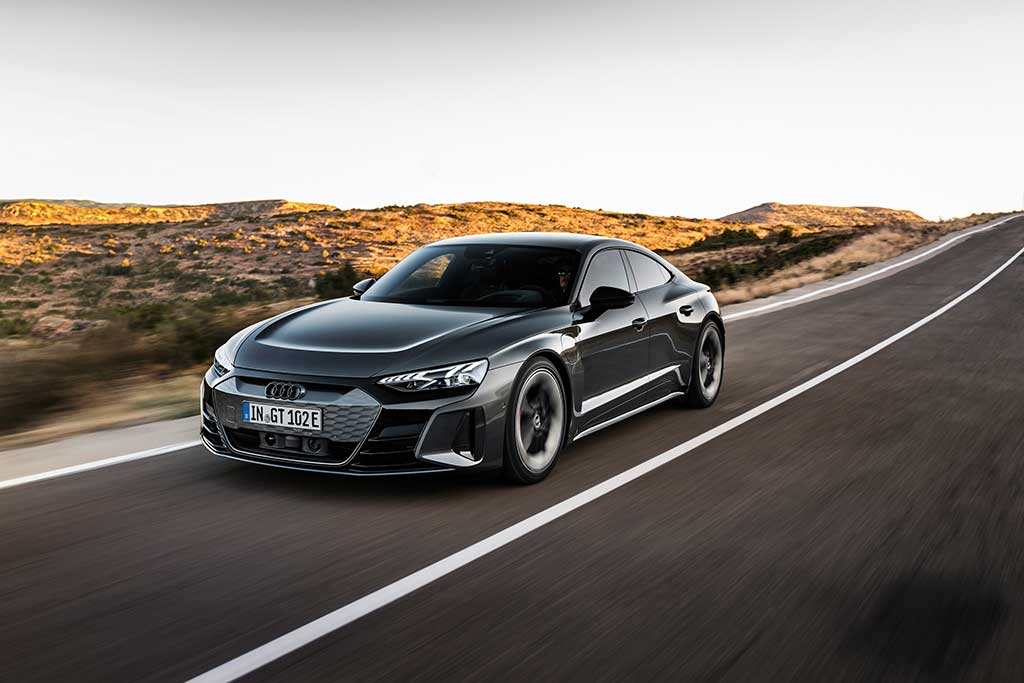
Wer beim flüchtigen Blick auf die Front an einen elektrischen R8 denkt, liegt falsch. Das Kürzel GT und die Maße erinnern vielleicht auch eher an den A7. Am nächsten kommt man der Wahrheit aber, wenn man sich seinen Plattform-Verwandten, den Porsche Taycan in Erinnerung ruft. Die e-tron-Leistung liegt in etwa auf dem Niveau des Taycan 4S, allerdings liegt der Einstiegspreis dabei knapp 6.500€ unter dem Konzernbruder. In der Pipeline ist dazu noch eine RS-Variante, die dann im Boostmodus kurzzeitig sogar über die 600PS Marke hinausgeht. Sicher platziert sich der Gran Turismo nicht zuletzt mit Seitenblick auf Teslas Model S, der allerdings mit den Plaid-Versionen mittlerweile im vierstelligen PS-Bereich liegt. Innen ist der GT vergleichsweise „knopflastig“, schon fast klassisch vom Layout her. Vielleicht ist die Idee dahinter, dass bei höheren Geschwindigkeiten die Hand eine haptische Orientierung benötigt. Oder womöglich wünschen sich Kunden zunehmend weniger Touch und mehr Feel. Die futuristischen digitalen Außenspiegel vom SUV-Namensvetter mit der gewöhnungsbedürftigen Platzierung der Bildschirme sucht man im GT jedenfalls vergeblich. So kommt der Sportler schon fast ein wenig konservativ daher im Vergleich zu seinem hochbeinigen etablierten Bruder. Die 92-seitige Preisliste lässt wie gewohnt auch hier kaum etwas vermissen. Glücklicherweise konnte man angesichts des knapp unter sechsstelligen Grundpreises aber darauf verzichten, wie beim e-tron ohne GT die Sitzheizung in Rechnung zu stellen. Schließlich musste man sich im Pricing-Team in Ingolstadt keine Gedanken machen, ob und wie man den Stromer preislich unter die Obergrenze des BAFA und damit auf die Liste der förderfähigen Modelle bekommt. Wer einen e-tron GT fährt, braucht keine Ökoprämie zum Kaufanreiz, sondern genießt elektrotypische, binäre Leistungsentfaltung, das moderne Premium-Interieur und das Wissen, in einem Statussymbol zu sitzen. Ob für Letzteres allerdings in Zeiten sich überschlagender Leistungsdaten Audis aktuelle Parameter ausreichen, bleibt abzuwarten. Faktisch untermotorisiert ist er allerdings sicher nicht und mit der vom Taycan übernommenen Technik ist auch das Aufladen im Bestfall nur noch Sache einer verlängerten Kaffeepause.
Subaru Outback – Der Junge muss an die frische Luft
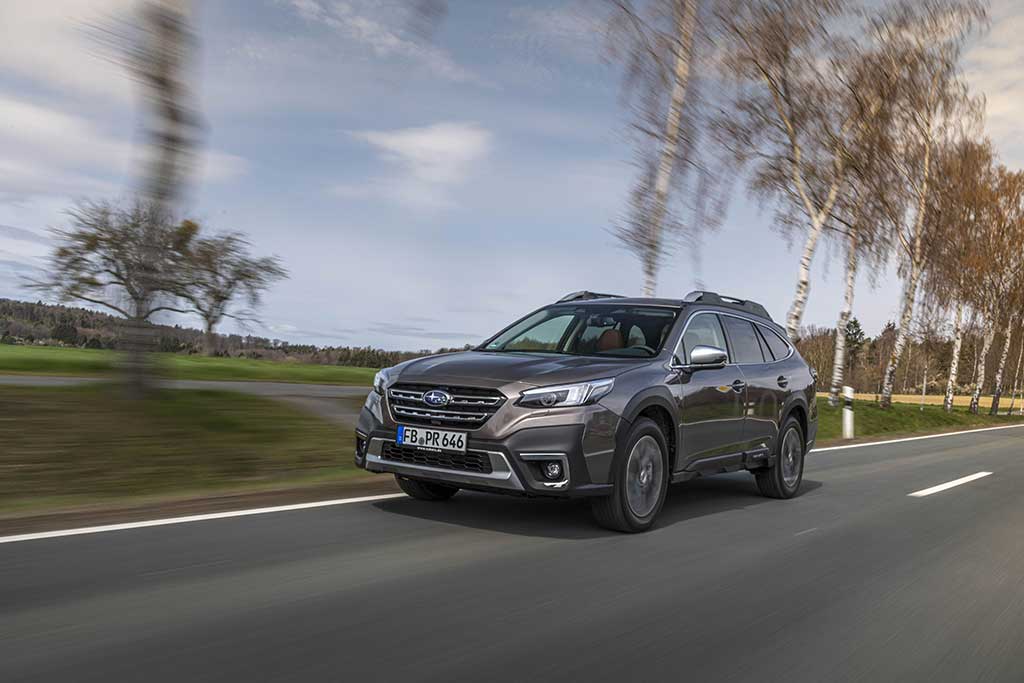
Obwohl der neue Outback auf Subarus Homepage weder von der Reihenfolge noch von der Abbildung her den Eindruck erweckt, stellt er das größte aktuell in Deutschland angebotene Modell der Japaner dar. Größentechnisch liegt er irgendwo zwischen einem VW Passat Alltrack und dem nicht mehr angebotenen Opel Insignia Country Tourer. Anders als diese war der Outback allerdings schon immer und ausschließlich ein allradgetriebener geländetauglicher Kombi und kein nachträglich umgestalteter Flotten-Dienstwagen. Der Friedberger Deutschland-Importeur, der zur Emil-Frey-Gruppe gehört, ist sich auch nicht zu schade, die über Jahre etablierte Kernzielgruppe offen in allen Kommunikationskanälen abzuholen. Jagd & Forst, Hundebesitzer sowie Camping- und Outdoor-Freunde werden publikumswirksam angesprochen und geben dem in der Zulassungsstatistik deutlich hinter fast allen anderen japanischen Wettbewerbern liegenden Hersteller den Ruf von unverwüstlicher Praktikabilität und Zuverlässigkeit. Fünf Jahre Garantie tragen somit nicht nur zur Kundenzufriedenheit bei, sondern sind Ausdruck von Selbstvertrauen in die solide Technik. Bei so viel robustem Charme kommen manchmal Design und Komfort etwas zu kurz. Aber der neue Outback schafft es mit wertigen Materialien und beispielsweise dem großen digitalen Zentraldisplay sowie sehr guten, auf allen Plätzen beheizten und optional belederten Sitzen einen Hauch moderne Gediegenheit in den Innenraum zu bringen. Zudem sind die Ausstattungslinien bereits ab der Basis sowohl inhaltlich als auch kostenseitig sehr gut positioniert. Werksoptionen gibt es so gut wie nicht, wenn man mal von „Lack & Leder“ absieht. Eine kleine Schwäche stellt die einzig angebotene Boxermotorisierung dar. Der 169PS Automatik-Benziner der Energieeffizienzklasse C ist zwar zweckdienlich, aber passt nicht so recht in die Zeit. Die Stärken liegen somit erklärtermaßen in den Disziplinen Platz – reichlich, Ausstattung – umfangreich und Technik – unumstritten. Und das ist eine Menge für einen Listenpreis ab knapp 41.000€.
Dacia Sandero – Automobile Grundversorgung
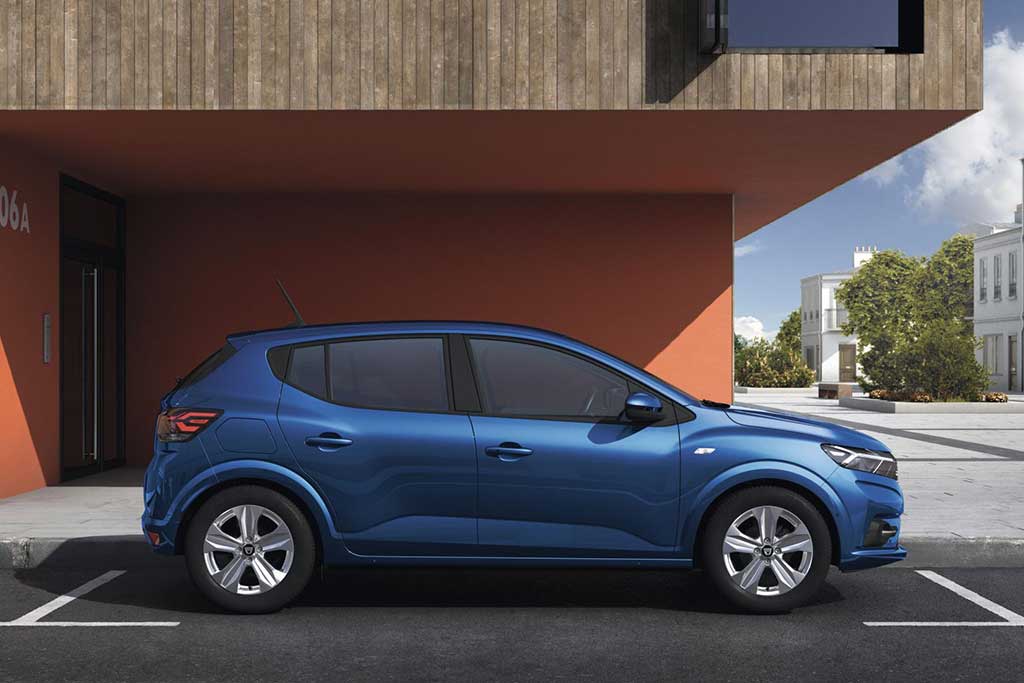
Zu einem e-tron GT setzt der Dacia Sandero einen absoluten Kontrapunkt. Kein elektrifizierter Antrieb, keine Leistungsorgie, und die Preisliste ist auch nur vier Seiten lang. Vier Räder und Türen hat er aber auch und er kann von sich behaupten, mit bis zu 7kW Motorleistung pro 1.000€ mehr fürs Geld zu bieten als so ziemlich alle anderen aktuellen Modelle. Nur mal zum Vergleich: Der e-tron GT kommt da gerade mal auf schwache 3,5 kW fürs gleiche Geld. Der Preis ist auch das wichtigste Argument für den meistverkauften Dacia. Selbst mit größter Anstrengung würde ein Verkäufer den Kleinwagen nicht über 18.000€ offiziellen Listenpreis bekommen. Außer er greift zum händlerseitig montiertem Zubehör. Keine der Werksoptionen und Pakete kostet dabei mehr als 700€. Dafür und theoretisch schon ab 8.690€ bekommen Kunden einen soliden und brauchbaren fahrbaren Untersatz mit der sprichwörtlichen Großserientechnik des Renault-Nissan-Konzerns. Drei Jahre Garantie gibt es dazu und sichert gegen einige Widrigkeiten ab. Ansprüche an hochwertige Materialien, aufwändige Verarbeitung, Individualisierungsmöglichkein oder eben Preis-Verhandlungsspielraum darf man entsprechend nicht anmelden. Ein frisches Design, pragmatische Lösungen und eine gute Grundausstattung an Sicherheitssystemen sind allerdings inbegriffen. Wer auch im laufenden Betrieb sparen will, greift zur Flüssiggasversion. Nicht unbedingt ein Ökomobil, aber ein paar Gramm weniger CO2 und trotz leichtem Mehrverbrauch einige Euro weniger an der Zapfsäule liefern Argumente für den aktuell leistungsstärksten Sandero. Die steuerliche Begünstigung des an der Tankstelle meist mit LPG abgekürzten Abfallprodukts aus der Benzinherstellung läuft Ende 2022 allerdings aus. Auch weiterhin wird wohl eher die Basismotorisierung in Kombination mit der höchsten Ausstattungslinie oder der etwas höher gelegten Stepway-Variante die meisten Käufer finden. Damit macht man neu wie gebraucht ganz sicher nichts falsch. Und für die hohen prozentualen Restwerte sorgt neben dem guten Preis-Leistungsverhältnis die Mathematik. Wo hohe Rabatte bei anderen Herstellern den Neuwagentransaktionspreis drücken und damit den rechnerischen Wertverlust zum Listenpreis künstlich aufblasen, beginnt die Restwertkurve des Sandero bereits knapp unter dem Listenpreis. Ein Hoch auf Adam Riese!
Updated whitepaper: How will COVID-19 shape used-car markets?
The latest edition of Autovista Group’s whitepaper: How will COVID-19 shape used-car markets? considers the third-wave of coronavirus infections across Europe, and looks at the lessons learned a year since the pandemic first hit the continent.
The whitepaper covers topics including:
- One year into COVID-19 and the lessons of resilience
- Used-car markets 2021 – crisis? What crisis?
- Electric vehicle (EV) tax guide
- Europe’s used-car market forecasts for 2021 and 2022
Following the emergence of Europe’s automotive sector from COVID-19 lockdowns, a three-speed development of residual values (RVs) has prevailed across the region. Autovista Group’s COVID-19 tracker, which covers 12 European markets, has revealed that residual value (RV) indices for a number of countries have returned to pre-crisis levels. Some, however, are still struggling.
Autovista Group experts discussed the whitepaper findings in the company’s latest webinar – Europe’s used-car markets – recovery from COVID-19. You can watch the presentation below.
Remaining strong
Used-car markets have proven more resilient than expected. In fact, the pandemic has helped some developments over the finish line that have long been in the making. For example, online sales, an advance that the automotive industry was slow to adopt until COVID-19 made it a necessity. Also supply-chain disruption has pushed demand towards the used-car sector.
In addition, the latest whitepaper looks at forecasts for RV development in Europe for 2021 and 2022. Autovista Group experts analyse the latest trends and scenarios for used-car market development across the continent. As countries are hit by a third-wave of infections, economic recovery may yet extend into 2022, even as vaccination programmes pick up their pace.
You can find more information about how different markets are shaping up, and the various economic scenarios across the region, in the latest update of the Autovista Group whitepaper – ‘How will COVID-19 shape used car markets’ – which can be viewed here.
European new-car registration figures deceptive on first inspection
Registrations in Europe’s biggest markets saw improvements in March 2021, some more dramatic than others. But as Daily Brief editor Phil Curry explains, all is not as it seems.
To get notifications for all the latest videos, you can subscribe for free to the Autovista Group Daily Brief YouTube channel.
SHOW NOTES
European registration rates on slow road to recovery
UK registrations ‘grow’ in March against COVID backdrop
German registrations start slow recovery in March
EU new-car registrations March bounce reflects devastating 2020
Launch Report: BMW iX3 – conventional and balanced electrification
The iX3 is BMW’s first pure-electric X model and is the most conventional, being effectively a battery-electric vehicle (BEV) version of the best-selling X3.
The iX3 offers good performance, with strong linear acceleration – as usual for a battery-electric vehicle (BEV). The model also strikes a good balance between power and battery capacity, with competitive electricity consumption. In terms of agility and dynamics, the iX3 is slightly better than its direct rivals overall. As the battery is located under the car, this also explains the good roadholding.
Standard equipment is comprehensive, including three-zone climate control, heated and powered front seats (with memory function on the driver’s side), BMW Teleservices and wireless phone charging. Safety features include emergency-assist and rear cross-traffic alert. The 458km range of the iX3 is second only to the Jaguar I-Pace’s 470km range, and it has the fastest charging time when connected to an 11kw AC wallbox, of 7.5 hours.
In addition to BMW’s strong brand image, the iX3 is supported by the company’s longer expertise in electrification. This started with the i3, which has been on the market since 2013, and was followed by plug-in hybrid (PHEV) engines offered on different models in the range, including one for the brand’s X family.
As the first conventional BEV from BMW, the iX3 compares well against key competitors. It is offered at an attractive entry price point and the popularity of both the brand and the X3 range should ensure plenty of demand. Given that the iX3 is very close to the X3, BMW’s D-SUV range is now available in diesel, petrol, PHEV and BEV versions.
Click here or on the image below to read Autovista Group’s benchmarking of the BMW iX3 in France, Spain and the UK. The interactive launch report presents new prices, forecast RVs and SWOT (strengths, weaknesses, opportunities and threats) analysis.


 Schließen
Schließen